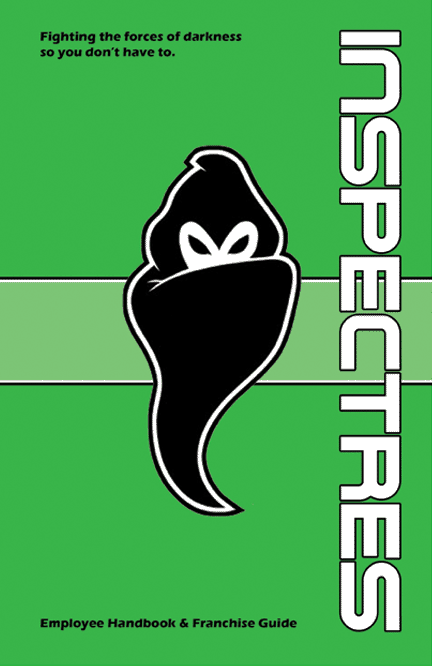RPG Reviews
Tabletop RPG Reviews by David Schirduan.
I read WAY more tabletop RPGs than I’ll ever get to play. This review list exists to justify the time and money I’m spending on these things.
- I have NOT played all of these…but I did read them front start to finish.
- They are listed alphabetically, but some of my reviews are a decade old. Take everything with a grain of salt.
- I don’t care if a game is good or bad, I mostly discuss things that interest me.
Table of Contents Permalink
- 200 Word Alphabet
- All Out of Bubblegum
- Always/Never/Now
- Anima Prime
- Ars Magica
- BARON MUNCHAUSEN
- Becoming: A Game of Heroism and Sacrifice
- Belly of the Beast
- Binomial Game Jam
- Black Hack Second Edition
- Blades in the Dark
- Cloud Empress
- Clover
- Critical Core
- Daytrippers
- Desert Moon of Karth for Mothership
- Do: Pilgrims of the Flying Temple
- Dread
- Dungeon Crawl Classics
- Dungeon World
- Durance
- Eclipse Phase
- Enter the Shadowside: Destiny
- Feng Shui 2
- First Fable
- Five Torches Deep
- Fungi of the Far Realms & Herbalists Primer
- Gællæffa Guide to Troika!
- Gardens of Ynn
- Girl Underground
- Goblin Quest
- Gourmet Street
- Haunted Almanac
- Headspace
- Heart of the Atom Isa
- Hot Springs Island
- Index Card RPG
- Indie Hack
- Into the Wyrd and Wild
- Inspectres
- Into the Odd
- Isle
- Knave
- Legend
- Magical Industrial Revolution
- Monster of the Week
- Motobushido
- Magical Murder Mansion
- Mysterious Menagerie of Doctor Orville Boros
- Nova Praxis
- Numenera
- Parsely
- PuppetLand
- Quiet Year
- Sailors on a Starless Sea
- Sea Queen Escapes
- Servants of the Cinder Queen
- Shadows of Esteren
- Silent Titans
- Stars Without Number
- Strange
- Stygian Garden of Abelia Prymm
- Stygian Library
- Sun King’s Palage
- Sunken Fort
- Synthicide
- They Cried Monster
- To Stand Before the Dragon’s Wrath
- Tomb of the Serpent Kings
- Tower of the Black Pearl
- Tower of the Stargazer
- Troika!
- TrollBabe
- Ultraviolet Grasslands
- Unbound
- Uncharted Worlds
- Vagabonds of Dyfed
- Vow of Honor
- Warrior Poet
- Winter’s Daughter
- Wushu
200 Word Alphabet Permalink

As this year’s 200 Word RPG Challenge was ramping up I wanted to take a look back and review some of the lesser known entries from previous years. So every day I reviewed one entry for each letter of the alphabet. This was a fun way to force myself to look at games I might otherwise pass over. Check it out for 27 reviews of these bite-sized games.
All Out of Bubblegum Permalink

Created by Michael “Epoch” Sullivan and Jeffery Grant, the same minds behind Everyone Is John. Bubblegum features the brilliant one-page wackiness you might expect.
The rules are only a page long (just go read them), but they naturally encourage games that mimic action-movies. Unlike games like Feng-Shui, Bubble Gum doesn’t focus on combat as much as it focuses on violence as a solution.
There are only two kinds of actions: Kicking Ass, and everything else. Bubblegum forces players to follow Action Movie cliches. As the game goes on and your supply of bubble gum starts to run low, you’re forced to solve your problems with outrageous acts of violence. This forces the game to naturally escalate. Instead of opening a door, you must smash it down. Instead of driving a car you leap through the windshield, punch the starter, and flashkick the steering wheel into position.
Now are you gonna do something? Or are you just gonna sit there and read?
Always/Never/Now Permalink

Created by Will Hindmarch
Always Never Now began as an adventure/hack of Lady Blackbird. It eventually blossomed into it’s own thing with house rules, a new setting, and new ideas.
While most games describe the game itself and may include an adventure or two, ANN is really an adventure with some included rules. A noir cyberpunk adventure to be precise.
The game features an intricate scene-flow diagram, several different ways to connect events, structures of play, existing characters, multiple outcomes, etc. It looks more like the storyboard to a point and click adventure than a traditional RPG module.
I would love to see more games focus down to a specific adventure. Rather than creating a framework for many adventures, ANN shows how strong a game can be when it narrows it’s focus to tell one specific story.
Anima Prime Permalink
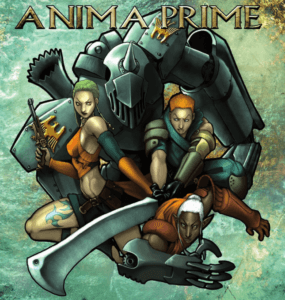
Created by Christian Griffen
This system is designed for adventures like Final Fantasy and Avatar the Last Airbender. It’s made to accommodate the many tropes and archetypes of these genres. The game uses a dice-pool system for attacks and spells, and focuses on specific abilities, rather than customize-able combat mechanics. The combat only takes up one page, with attacks and abilities adding more complexity.
Anima Prime does two things extremely well:
1) Gate off complexity. The main combat mechanics only take up a single page and a dirt simple. Instead the complexity and strategy is offloaded onto character abilities and special moves. Characters may play vastly different from one another, but each player only needs to know enough rules for their own character. Only the firebender needs to know how firebending works, and only the mech driver needs to know how mechs work.
2) Packages. There are a lot of character options to choose from. This is unavoidable considering how many anime properties it’s trying to emulate. To keep the game from grinding to a halt at the start, the GM can simply offer the players pre-made packages that mirror well known characters. Child Monk. Sparker. FlameCaster. Healer. This lets the players grab a package, write down their powers, and jump right in.
Anima Prime knows what it is: It’s the game you pick when you want to play Final Fantasy, Avatar, or DragonBall Z. Prime does a great job of giving players what they need and not trying to shoehorn in things they don’t care about.
Ars Magica Permalink
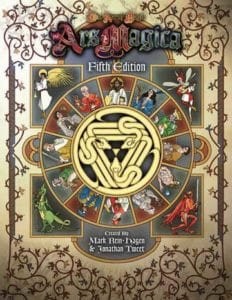
Created by Atlas Games
An RPG set in Mythic Europe of 1220. The setting is based in this reality, with a thick layering of mythos and magic.
The magic system in this game is famous for a very good reason: it is incredibly deep, well thought out, and flexible. The system requires a deep understanding of the philosophy behind the hermetic arts. If a player spends time and study of this system, they will be more effective than someone who doesn’t; levels and character sheet be damned. It’s rare to find a game that relies so heavily on player knowledge and understanding, rather than character skills.
On the other side of the coin, Ars Magica’s flexibility is to it’s detriment. Using this system, one could easily melt a castle, turn an enemy to glass, or make their opponents think they are already dead. Ars Magica’s attempt to balance this with mechanics is…..obtuse to say the least. Mechanics are complicated, simple spells take forever to crunch through, and extensive preparation is required for every adventure/action.
Ars Magicka attempts to corral a fascinating concept with mechanics. Some ideas are incredibly hard to contain and balance within a game’s system. But Ars Magicka tries.
BARON MUNCHAUSEN Permalink
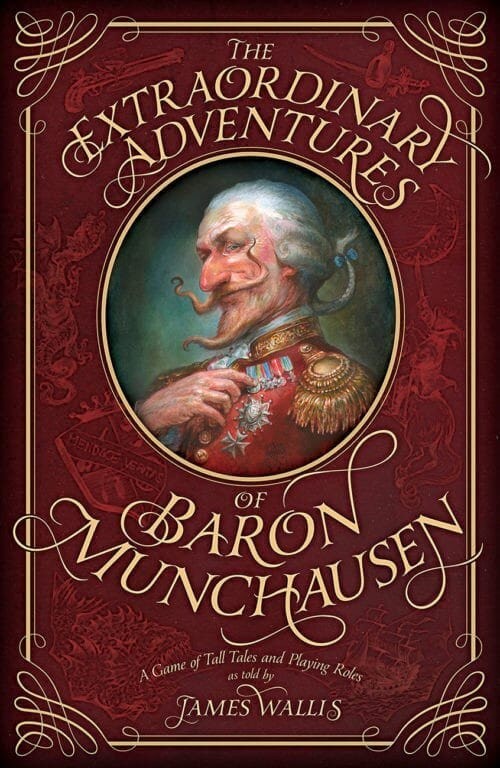
created by James Wallis
Wow. The amount of character, clever writing, and 18th century humor in this game is astonishing. I still can’t get over how every page oozes with classical British “Hmph, well I say!”, and makes me smile. Written in the “Baron’s own hand”, this book describes how to play a game where everyone sits around a table and tries to out-do each other with greater and more fantastic stories. The game can be played with dice and pencils, but has rules for playing with wine, cigars, money, and anything else a classy person might have.
The fun part is that each adventure is prompted by someone else. So you ask the person next to you: “Most honoured and noble prince, if you could refrain momentarily from the gracious attentions you are paying to my sister, mayhap you might satisfy our curiosity on the matter of how it was that you escaped from the prison of Akkra after you had been burned at the stake there two days earlier ?”
Whoever tells the most imaginative story wins. The sheer amount of substance and humor is probably the main draw for this game. If any of you wish to admire pristine writing, tone, and atmosphere, this is easily one of the best I’ve ever read.
Becoming: A Game of Heroism and Sacrifice Permalink
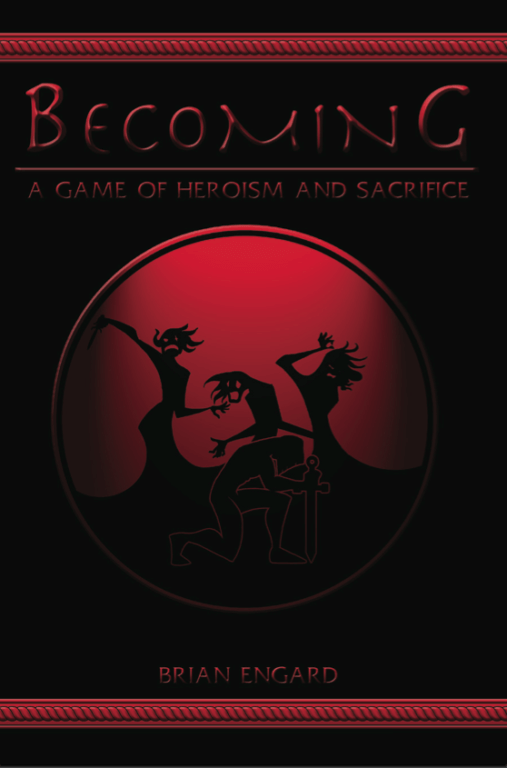
Created by Brian Engard
This game mixes up the traditional RPG setup. One player takes the role of a hero, while the other players each assume the roles of the Fates, giving the hero trials, troubles, and adventures. Each of the Fates has their own motivations and abilities. They try to turn the Hero into something else, while the Hero tries to maintain their character in spite of these trials. There is a lot of information for making your own heroes, quests, and fates.
This is a very interesting system, focusing on motivation and roles. Everyone has a defined role, and is expected to act within their roles. I really like this archetypal setup, with clear boundaries on either side. I also like how this game embraces cliches and archetypes, and in fact relies upon them.
This game requires a LOT of dice, at least 60+ if I read the rules correctly. It also requires that players do not stray too far outside of their goals and limits. There are not a lot mechanics, but strict roles and motivations. This is great for the story-telling game, but depends upon a disciplined group of players self-refereeing and keeping themselves in line. It is also limited to 4 players, no more, no less.
Belly of the Beast Permalink
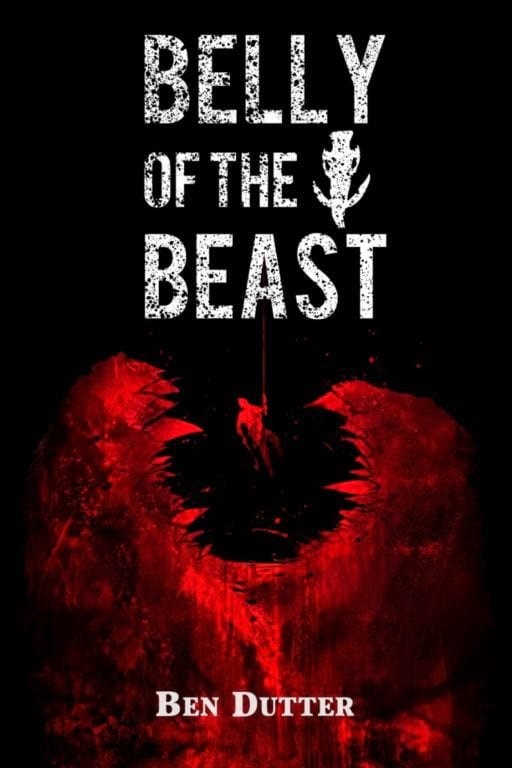
Created by Ben Dutter
As a huge fan of Vow of Honor, I was a little dubious about Belly of the Beast, which uses the same mechanics.
BotB is set inside the guts of a ginormous world-eating monster from space. It is SO big and so huge that entire cities have been swallowed whole, and the survivors struggle to rebuild society. This guts of The Beast have their own weather patterns and echo systems. Fresh water is rare, and eating the flesh of The Beast will drive a person mad.
While Vow of Honor revolved around a strict code of behavior, BotB gives every scavenger a list of Instincts and special skills that they can draw upon to survive. The game is structured around “Pulls” or missions to recover supplies, artifacts, and so on.
With such an incredible setting and a unique concept, Belly of the Beast really grabs the imagination. I could see this being run as a dark, gross game of survival, or as strange, trippy game of exploring old ruins in a weird world.
Binomial Game Jam Permalink
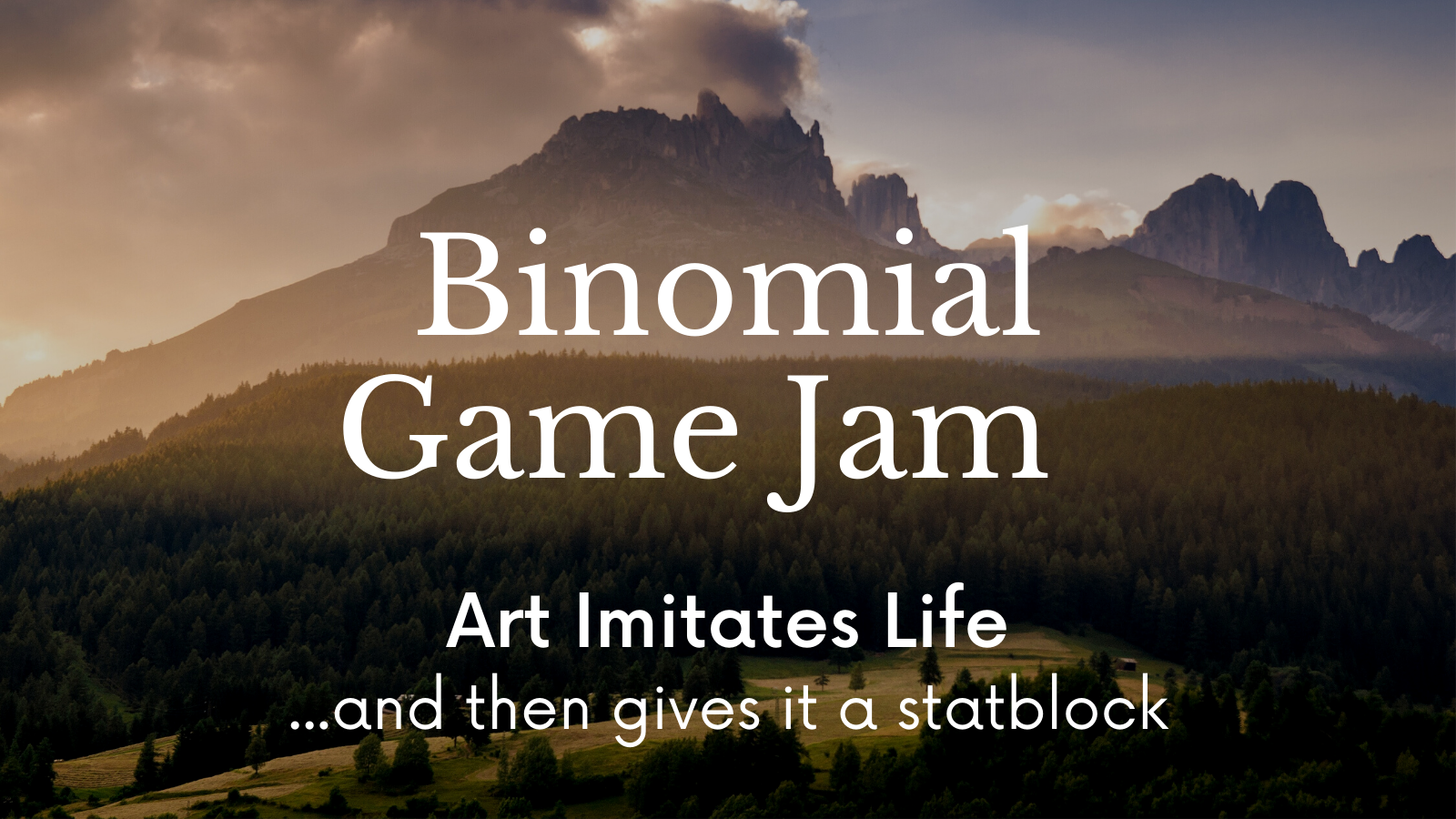
Inspired by our newest game, Bones Deep, my wife and I launched a quick and dirty design jam via Itch.io. We called it the “Binomial Game Jam” and encouraged other designers to make content inspired by real-world creatures. You can learn more on the contest page, but in this post we’re going to take a deep dive and look at all the submissions.
Submissions will be reviewed in the order they were submitted. My aim is not to critique these entries, but rather to celebrate what they’ve created and encourage the reader to check them out.
Black Hack Second Edition Permalink
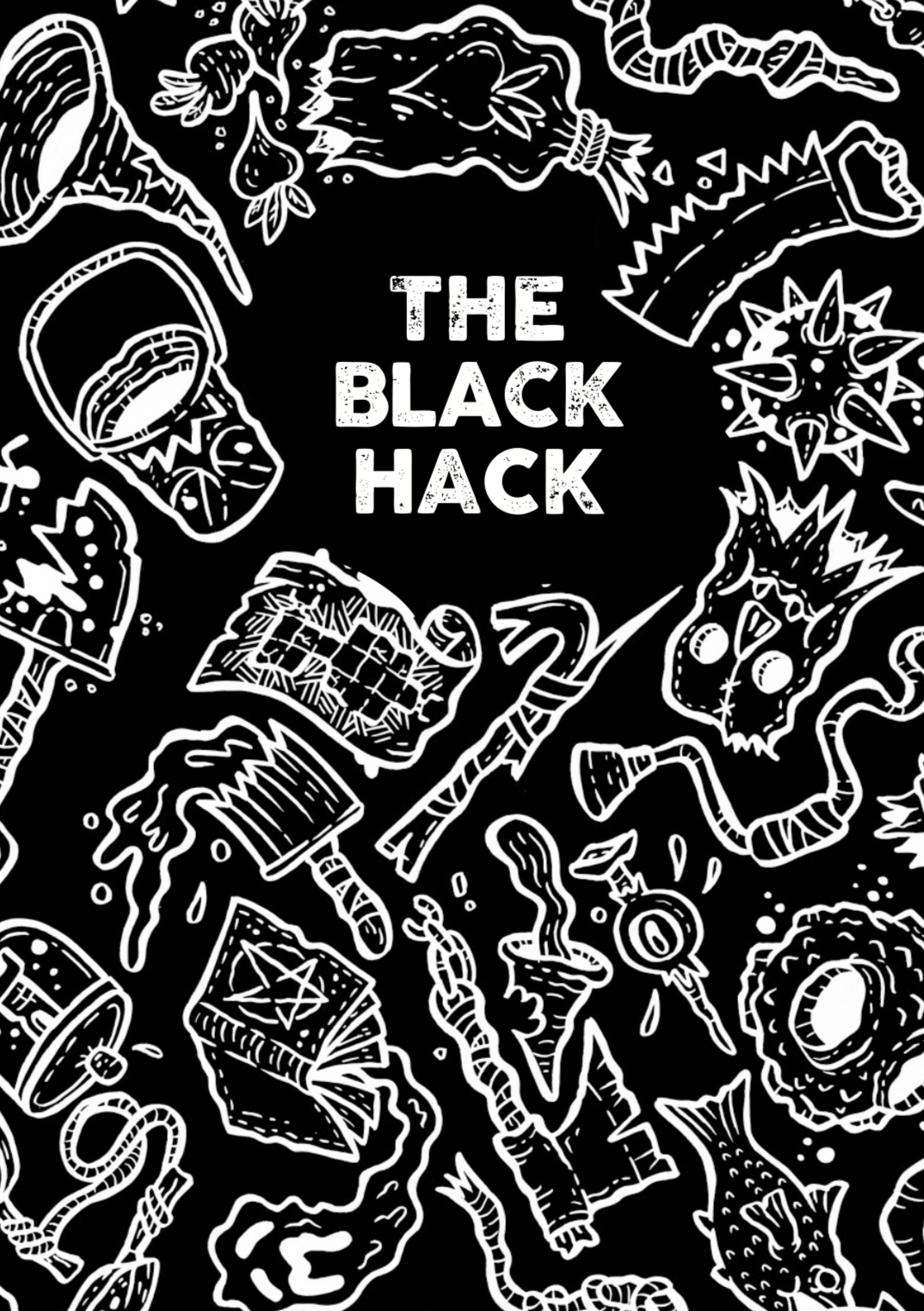
Created by David Black
Wow.
I mean.
Wow.
This book is a gem y’all. I am completely blown away. So flabbergasted that the only way to continue this “review” is with random exclamations and disjointed commentary.
AHEM. Let’s begin.
Blades in the Dark Permalink
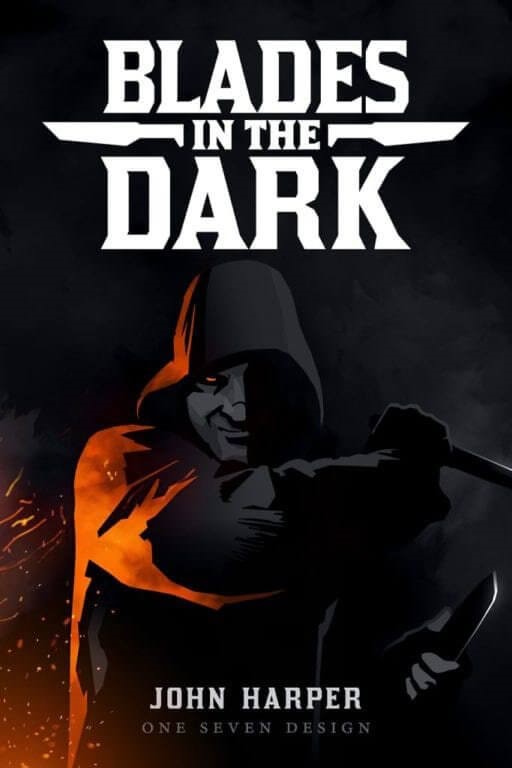
Created by John Harper
“Blades in the Dark is a game about a group of daring scoundrels building a criminal enterprise on the haunted streets of an industrial-fantasy city. There are heists, chases, escapes, dangerous bargains, bloody skirmishes, deceptions, betrayals, victories, and deaths. You’re in a haunted Victorian-era city trapped inside a wall of lightning powered by demon blood.”
Inspired by the same base rules as Dungeon World, Blades add two major twists that really grabbed me:
1) Focus on Flashbacks. One of the key tenants of Blades is that you jump right into the action. Even on a complicated heist, your group only works out the most basic details: “We go in the back while you attack the front.” Then the heist begins. If players ever bump into an obstacle that they didn’t expect, they can have a short flashback detailing how they planned ahead for this. “Oh no, the door is locked? Well good thing we knew to pack climbing gear 5 hours earlier.” This keeps the game fast and loose.
2) Gangs and Turf. In addition to character sheets, your gang also has a sheet. The players can perform jobs, pay bribes, or intimidate other gangs to spread their influence. As your gang levels up you can tackle bigger and bigger jobs. Maybe one day you’ll run this godforsaken place!
The flashbacks and the focus on expanding the gang prevents players from spending the entire session making a plan that will fall apart. It cribs a lot of great ideas from board games by keeping players engaged mechanically and in the fiction. I absolutely adore it, and since Dungeon World, this has become my new darling.
Cloud Empress Permalink
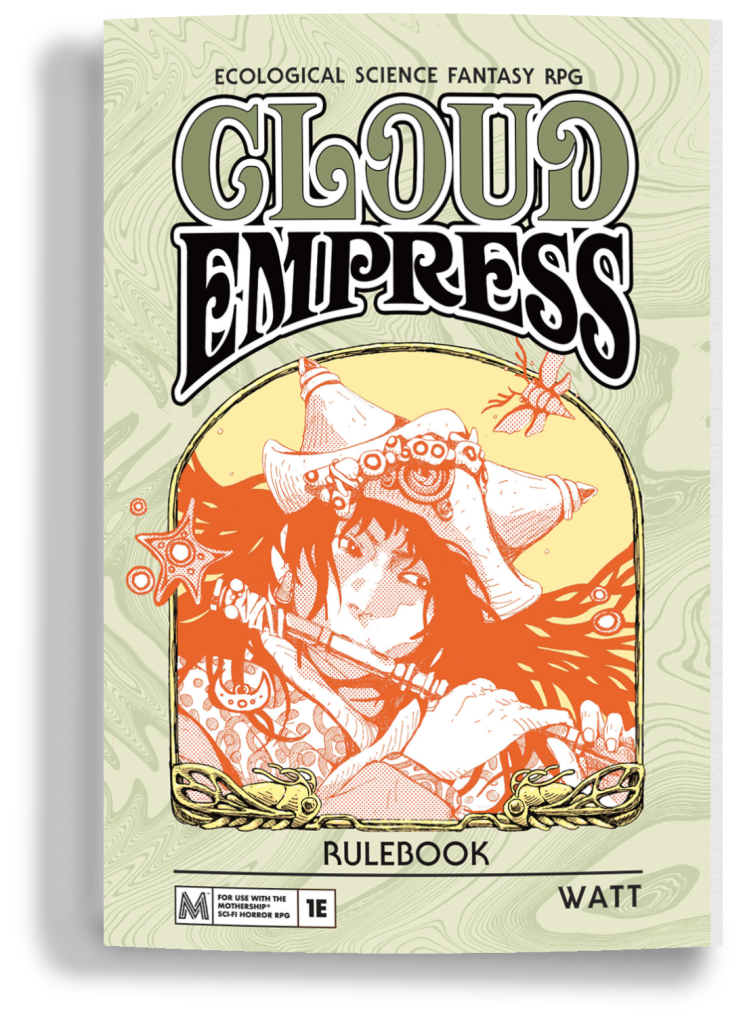
created by worlds by watt
For the past 6 months I’ve been running a weekly game of Cloud Empress. And it was INCREDIBLE! This will be an absolutely glowing review, with a few minor criticisms followed by a play report.
Let us descend to the Lowland Wastes. A land of cicadas, invading soldiers, mysterious sporekeepers, brood monks, and most importantly, a land of adventure!
After my fantastic experience with Desert Moon of Karth, I wanted to try more Mothership. But I still didn’t want to play a traditional horror game.
So as I was getting excited about Cloud Empress and saw that it was based on Mothership, I knew I had to give it a try. A couple things that piqued my interest…
Clover Permalink

created by Tao Games
I really like this rpg. The mechanics are non-existent, there’s almost no character creation, GM advice is sparse at best, and the whole thing is only 20 pages long. But it is so heartfelt and precious that I cannot help but like it.
You and your friends play as a 5 year old girl named Clover and her friends. The GM is Clover’s dad, and guides her throughout her day and through most of her adventures. The only goal is to let yourself regress to your childhood days and ask your dad questions like “Can I go over there and play pretend with May?” “I want to see what’s behind the woods in our house. Will you come with me?” The guidance and tone of the game is more about communicating a feeling, and reading the “rules” while skimming the pictures makes me want to grab my 20-something friends and go build a tree fort out back.
“To play the game, you must devote an some time to play it with your friends. In playing, you imagine this girl and her friends in their lives, asking questions and saying what they say and what they do. There is no way to win. You just play because the experience is fun. So don’t play it with anyone mean.” -From their website.
The main reason Clover is on this list is for the warm feelings that it evokes, as well as the innocent naivete that this game requires. Not a lot of games evoke those feelings in me. Even if I never play it. it still sticks with me.
Critical Core Permalink
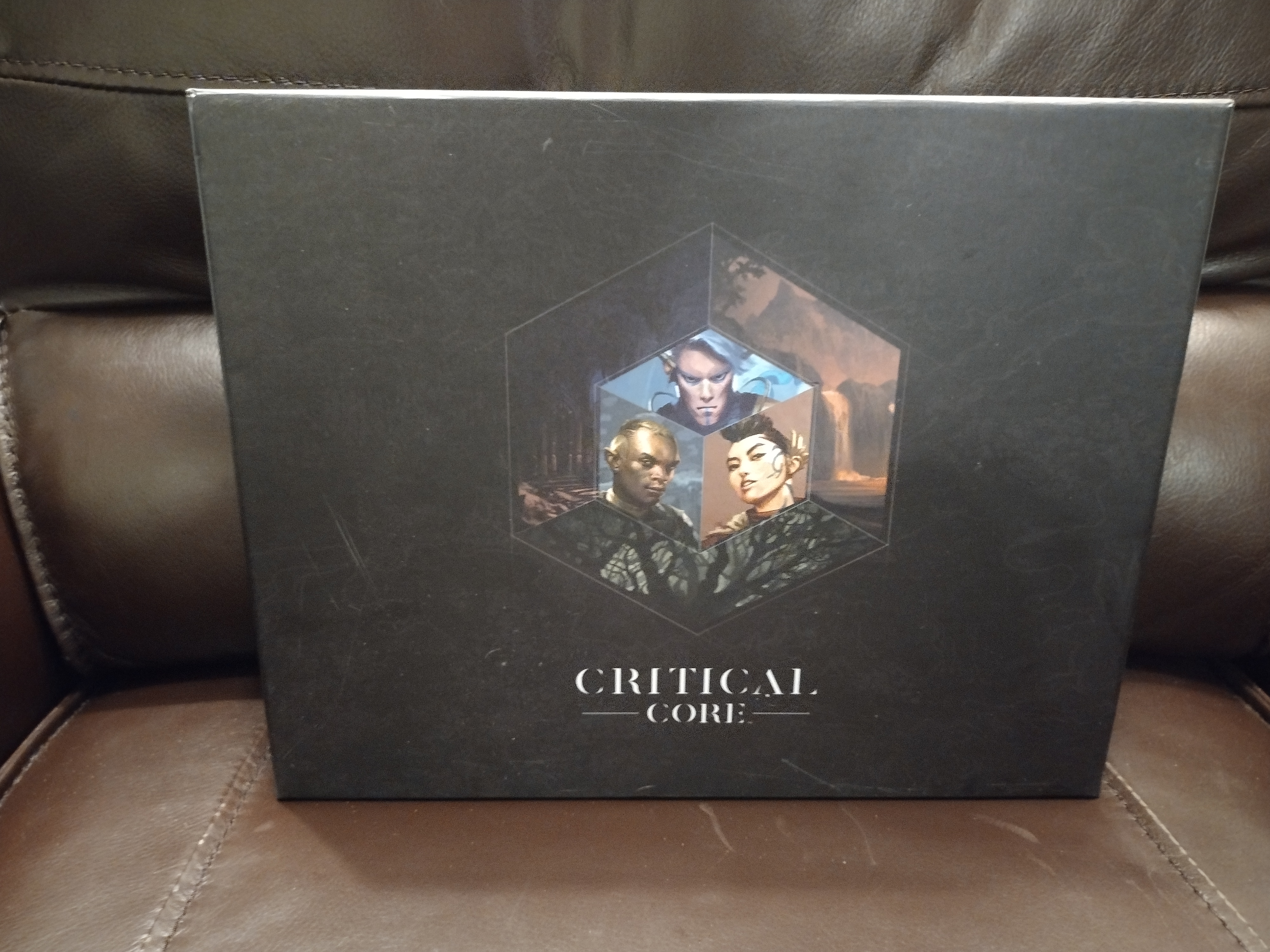
created by Game to Grow
This will be a review of two parts. In this first part it’s just me, David. I’ll provide an overview of the game, look at some interesting design choices, show off the fascinating layout, and conclude with my excitement and hope for our hobby. But I am not a counselor, teacher, or therapist. I’m just a big nerd.
Part 2 will feature interviews with several counselors, therapists, and teachers who have used RPGs as a teaching tool. We’ll do a much deeper dive on how well Critical Core accomplishes its primary goals.
When I saw the Critical Core pitch on Kickstarter I was immediately hooked.
Critical Core is a tabletop role-playing game designed to help kids on the autism spectrum build social skills and confidence. It’s a great way for parents to engage with their children at home, and for professionals and experienced gamers to use as a group social skills tool.
Obviously, I’m passionate about the positive impact that RPGs can have. I’ve personally benefited from the community and storytelling that emerges from a gaming table. Additionally, my wife has experience working as a behavioral therapist with special needs children. For us, even if Critical Core was a massive failure, we were excited to learn from it and see how Game to Grow tackles this challenge and what we can learn from it.
Daytrippers Permalink
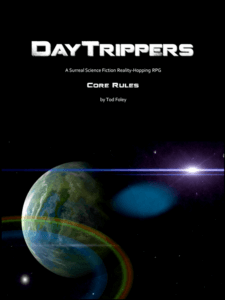
Created by Tod Foley
Daytrippers is an absurdist, psychedelic rpg system for auteur game masters.
…No, I don’t know what that means either. Let’s find out!
Set in an alternate (hopefully) future, the game takes place in a world that has JUST discovered spacetime travel. And, no, I didn’t miss a blank space between those two words. Daytrippers explores the idea that space travel and time travel are closely related, and in fact, can both happen at the same time. Read the rest of the review here…
Desert Moon of Karth for Mothership Permalink
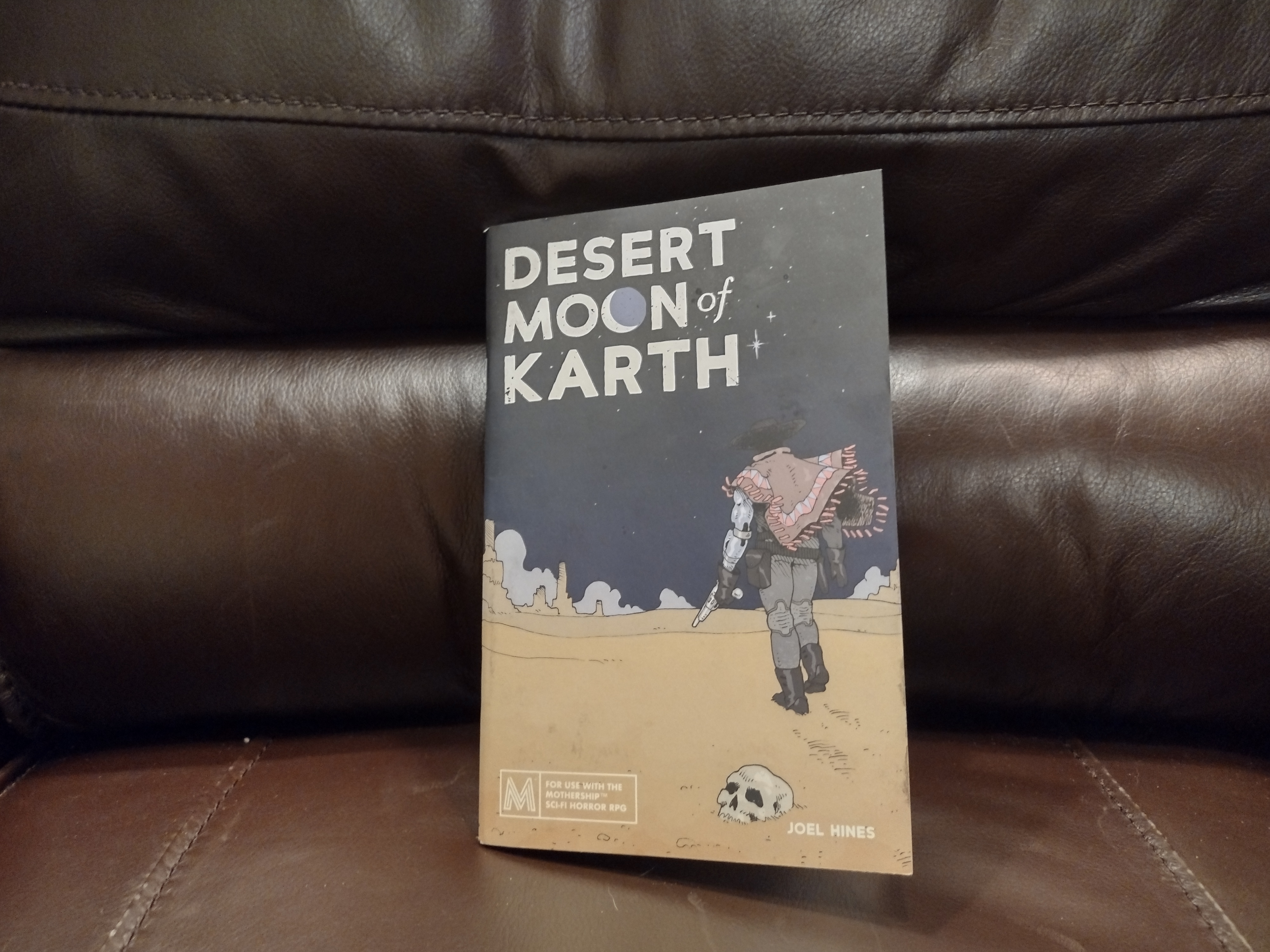
Created by Silverarm Press.
I grabbed Desert Moon of Karth because I needed one more product to qualify for free shipping from Exalted Funeral and the cover art sold me. It reminded me of my own game, Clink, and I’m a sucker for westerns.
As it turns out, Karth not only provides a fresh and exciting sci-fi romp, it was also the secret ingredient I needed to unlock Mothership.
Karth oozes charm. Every location has depth. Every NPC is nuanced or weird. Random encounters draw you deeper into the factions and encourage you to visit other locations. Every page has a dozen ideas to fuel your GM inspiration.
Do: Pilgrims of the Flying Temple Permalink
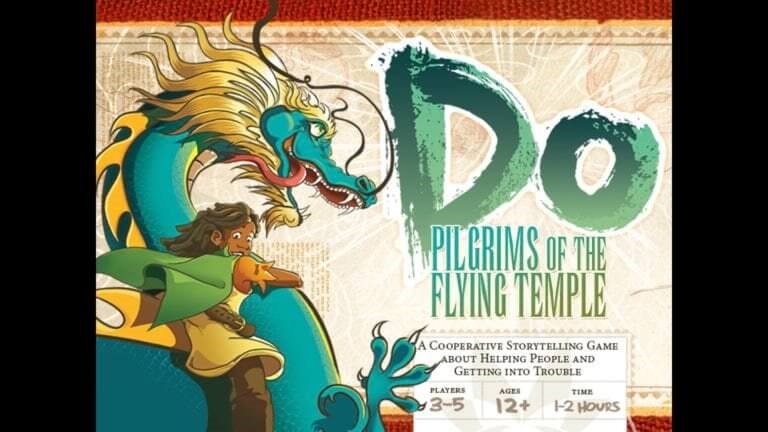
Created by Daniel Solis.
This is a game designed for kids 12+, which includes me! Players travel to strange lands and try to resolve problems. To create a character, each pilgrim writes down how they tend to get into trouble (curious, talkative, easily distracted, etc) and how they help people; usually relating to how you get into trouble (investigates where other’s don’t, talks people through their problems, notices things people miss). Pilgrims receive a letter detailing the world that needs help, and what the problem is. And then they go do that.
“You take the bag of 40 stones, 20 white, 20 black, and on your turn you’re the storyteller, everyone else is termed as troublemakers. You draw 3 and then you get to pick the white or the black stones. You have a marker with two sides. One of them indicates you’re in trouble. One that you’re not. There’s a handy little table that tells about how many stones you keep vs how many you put back in the bag.
The results either put you into or out of trouble, and you write a sentence using goal words from the letter depending on the results. If you manage to eventually cross off all the goal words, you get a parade ending. Things turn out good for you guys.
If someone gets 8 or more stones before you get all the goal words, you get a pitchforks ending, where things aren’t so good, and you get driven offworld for your meddling in their affairs. There’s some cleanup stuff after everything is done to change or retire characters, but that’s basically the idea.
Who writes the sentences (troublemakers or storyteller) is determined by what you choose to keep. So you’re trying to keep as few stones as possible while crossing off goal words. There’s a handy dandy letters book (of which I wrote a couple!) for premade letters too. :) The system for writing them is pretty simple.” – Description from AskJames
Really neat to see a game that encourages kids to embrace their faults and use their skills to overcome problems.
Dread Permalink
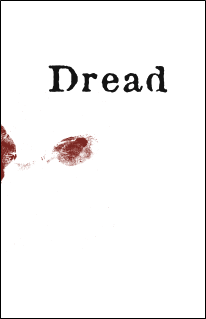
created by The Impossible Dream
If you haven’t heard about this game, prepare yourself. There are a lot of great horror games out there, most of them fairly complex, and all of them difficult and dangerous. Most horror games rely on high-risk dice mechanics to create that tension and danger that is so necessary for good suspense. But not Dread. Dread replaces traditional dice with a Jenga Tower.
And this works beautifully! The rules are dirt simple: whenever someone wants to perform a risky or dangerous action, they pull a Jenga tile. Refusal to pull the tile, or stopping halfway means your character fails that action. If you can pull out a tile, then your character succeeds. BUT! If the tower falls when you’re taking your action, you DIE. Death. ouch.
In most games, your HP or sanity represents how close characters are to death or insanity. In this game, the current state of the Jenga tower represents the groups mental fortitude and courage. It get’s REALLY intense when the tower is leaning to one side, and the mutant with the axe is chopping down the door, you don’t think you can pull a brick, but you HAVE to, otherwise he’ll get inside and then….
You get the idea. The book has a lot of great examples, GM advice, and scenarios included, but if you had to, you could just run the game with the quick-start rules for free on the website. Check it out if you want an intense and pulse-pounding game session!
Also, I wrote a little Sci Fi adventure for Dread, if you’re interested.
Dungeon Crawl Classics Permalink
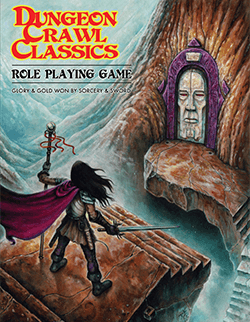
Created by Goodman Games
This huge 500+ page book hides within it a straightfoward classic RPG game. Most of the book is filled with spells, random tables, GM advice, monsters, and two included adventures. Highlights:
Tons of spells, each with 10+ different outcomes. Spellcasting is wild and unpredicatable.
Surprisingly simple system, my group was up and running in about 25 mins.
Fascinating character creation. Players start with a handful of weak peasants, and whoever survives the first meatgrinder adventure upgrades to a “real” character. This also acts like a tutorial mission for the game itself. Brilliant!
I didn’t think I would like it at first, but this game is filled with so much heart and clever mechancis that I keep coming back again and again. So far it’s my favorite of the OSR genre, right up there with Into the Odd.
Dungeon World Permalink
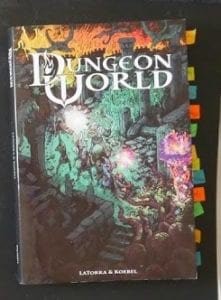
created by Adam Koebel and Sage Latorra
Dungeon World has a terrible name but a wonderful system. Although the setting and the characters are common cliches, Dungeon World brings something new to the table that completely changed how I run games.
The system relies on the concept of “moves”. Players can simply describe what they’re doing, and the mechanics don’t click in until they trigger a move. Walking across town, finding the bar, and talking to the sheriff won’t trigger any moves. Moves look like this:
When you attack an enemy in melee, roll two 6-sided dice and add STR:
- On a 10+, you deal your damage to the enemy and avoid their attack. At your option, you may choose to do +1d6 damage but expose yourself to the enemy’s attack.
- On a 7–9, you deal your damage to the enemy and the enemy makes an attack against you.
This means that most of the game is very rules lite, and the mechanics only kick in for interesting things. It has become the gold standard for me, and is my go-to game system. Also, the GM advice in this book is PURE gold. Any aspiring GM should pick it up and give it a skim just for the GM section alone.
Durance Permalink
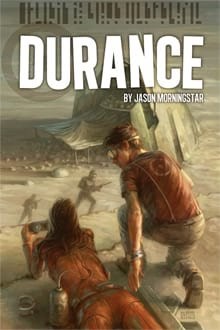
Created by Jason Morningstar
A futuristic sci-fi game taking place in a distant colony on the edge of civilization. People become colonists for a host of reasons, and embrace the chance to start anew in a harsh environment. One fun part of the game is the difference between how things are advertised, and how things ACTUALLY are. All colonies and situations have a public, clean description, while the reality is often darker and murkier. Instead of quests, characters have oaths that they must keep or break, and play out situations until the fun starts to run low.
This game has some of the best world and colony generation that I’ve seen. There are tables that you randomly roll up to select environments, planets, colonies, and threats. Everything blends together well, and no matter what combination you are guaranteed a great, grisly situation. This game also has some of the best political and social interaction/setup/focus. There are no combat rules, since combat is just one way to solve a problem.
Along with the stellar random generation tables, Durance succeeds at making situations that are physically and politically dangerous. It’s good to see games tackle more mundane, familiar struggles. The harsh environment just helps amplify everything that happens.
Eclipse Phase Permalink
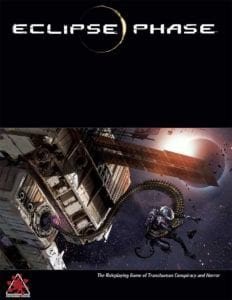
created by Posthuman Studios
Similar to Nova Praxis, Eclipse Phase takes place in the far future, where technology has advanced to incredible heights, and humanity has evolved beyond itself. So far has it come that most of society crashed, resulting in a far-future apocalypse. Unlike Nova Praxis, there is no main government or structure, and people live in an unstable anarchy and warring between factions.
Eclipse Phase focuses a lot more on Transhumanism than the Singularity. The tagline for the game is:
Your mind is software. Program it. Your body is a shell. Change it. Death is a disease. Cure it. Extinction is approaching. Fight it.
The setting introduces a type of crunch, with details of abilities, dimensions, and long skill lists adding much bookkeeping. Although the mechanics and rules are not overwhelming, this universe is very detailed and fully realized. That means a lot of research and knowledge of the setting is required by both GM and player. This is a not a pick-up and play type of game, but will provide a lot of depth for those willing to invest in it.
It is rare that a game’s setting is what makes it complicated, but in Eclipse Phase shows how intimidating and engaging a game’s setting can be.
Enter the Shadowside: Destiny Permalink
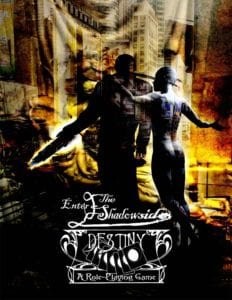
created by Marco Leon
Enter the Shadowside: Destiny is the newest edition of the series, and uses a new card mechanics that fascinated and grabbed me. I just love the idea of giving players the power of choosing when to succeed, and when to fail.
The book itself is very pretty, with some fantastic artwork. It’s well laid out, with lots of good advice, tips, factions, examples and more. The setting is a blend of modern day and mysticism; think The Dresden Files.
However, the author spends the rest of the Mechanics section explaining how his game is different from Dungeons and Dragons. He constantly talks smack about “other roleplaying games” and about how “games shouldn’t be so X,Y, or Z”. It really soured my enjoyment of the game, which is a real shame, because this game need not be so defensive; it stands just fine on its own.
When you have a unique idea, it can be tempting to focus on what you’re game isn’t, rather than what is it.
Feng Shui 2 Permalink
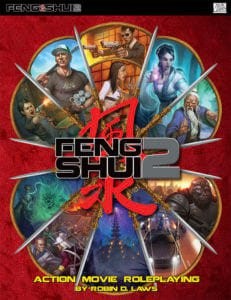
created by Robin D. Laws
My love of narrative combat games should be obvious by now. Between Wushu and Mythic Mortals, I always enjoy games that let me create epic fight scenes and adventures in a bug dumb action movie environment. Feng Shui 2 is the new edition of the game that did it first!
Feng Shui 2 aims to re-create 80’s and 90’s action movies with all the tropes and fun adventure that comes with them. Characters are encouraged to fit into a melodramatic stereotype. Classes have names like “Kung-Fu Cop”, “Old Master”, and “Big Bruiser”. Heck, you even have reload rolls; if you roll well enough, your guns never run out of bullets!
All of these little elements combine to make a game that is really easy to enjoy. Is it balanced? Fair? Well designed? That doesn’t matter. The writing, abilities, tone, and mechanics all lead to a ridiculous romp straight out of Big Trouble in Little China. Every time I break this game out, my group has a blast with it. I highly recommend it for any action movie lovers.
First Fable Permalink
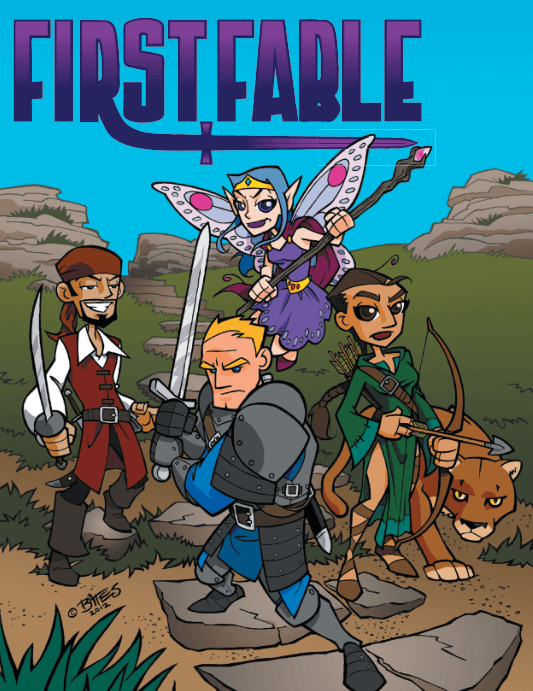
Created by Matthew McFarland
First Fable is an RPG geared towards adults running games for their kids. Recommended for Ages 8-12, First Fable intrigued me because of it’s GM advice and clever simplicity.
It’s not difficult to write a simple RPG. What’s more difficult is creating a game that let’s kids tell stories with JUST the right amount of structure and guidance. Not too much, not too little. The rules are straightforward, and the classes include “Pirate, Knight, Princess, and Animal Keeper” which is a great collection of basic classes. Characters have 3 stats (Strong, Fast, and Smart), some skills, abilities, and One Special Thing that can be used to overcome big challenges.
The part I love is the advice on Running the Game. It is written with a solid understanding of kids and how they would like to play. Suggestions on limiting playtime, how to handle violence, dealing with failure, etc. Really fantastic stuff.
If you want to play RPGs with young kids, the GM advice alone is worth a purchase. If you’re looking for an even younger audience, I’ve heard good things about Hero Kids, although it’s a little pricier.
Five Torches Deep Permalink
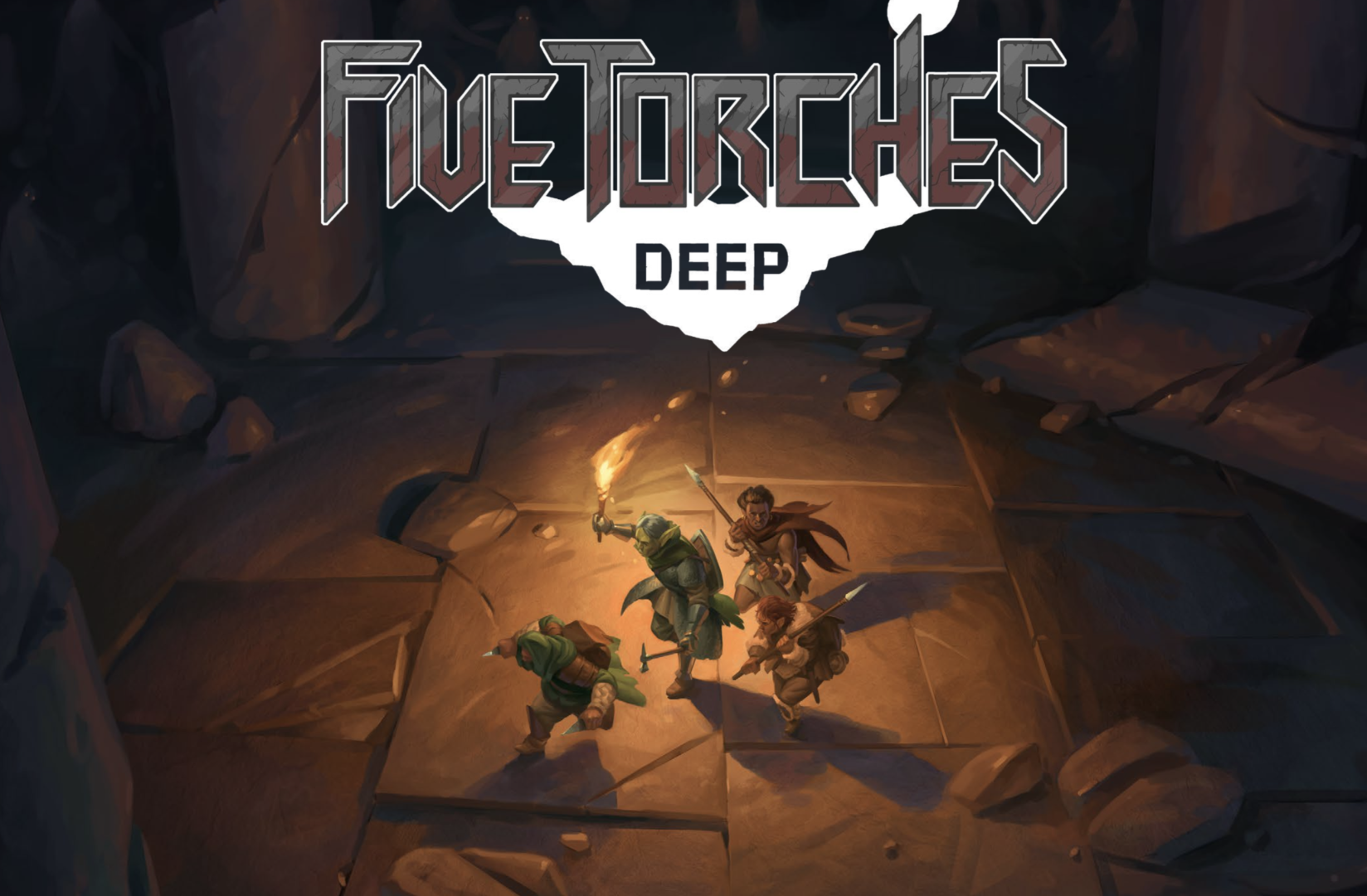
Created by Sigilstone Publishing
I’ve only played Dungeons and Dragons 4e (and that only for 4-5 sessions). Never played any other “official” version of D&D. Partly because I’m obsessed with weird, indie RPGs, but also because I can’t afford to drop $180 on three RPG books. (But I will spend $180 on like…seven indie darlings).
After my review on Vagabonds of Dyfed, I assumed Ben Dutter was done trying blend disparate things together.
I was wrong.
Five Torches Deep is his latest concoction: a blend of OSR sensibilities with streamlined D&D 5th Edition mechanics. Not only is Five Torches Deep compatible with both rulesets, but it brings some innovations in its own right.
Fungi of the Far Realms & Herbalists Primer Permalink

Today we’re going to take a look at plants in roleplaying games. With the announcement of the Herbalists Primer Kickstarter, it’s safe to say that a large audience exists; and they’re hungry for more!
So I called my mom, Heather (yes that’s her name, this isn’t a pun…I mean it IS a pun but it’s also real). She is a talented gardener and educator but has ZERO experience with RPGs (aside from trying to understand why people enjoy my weird books).
What follows is a series of interview questions about plants, games, stories, and dirt. Lots of dirt. We take a look at three books and examining their gardening and gaming potential.
Gællæffa Guide to Troika! Permalink
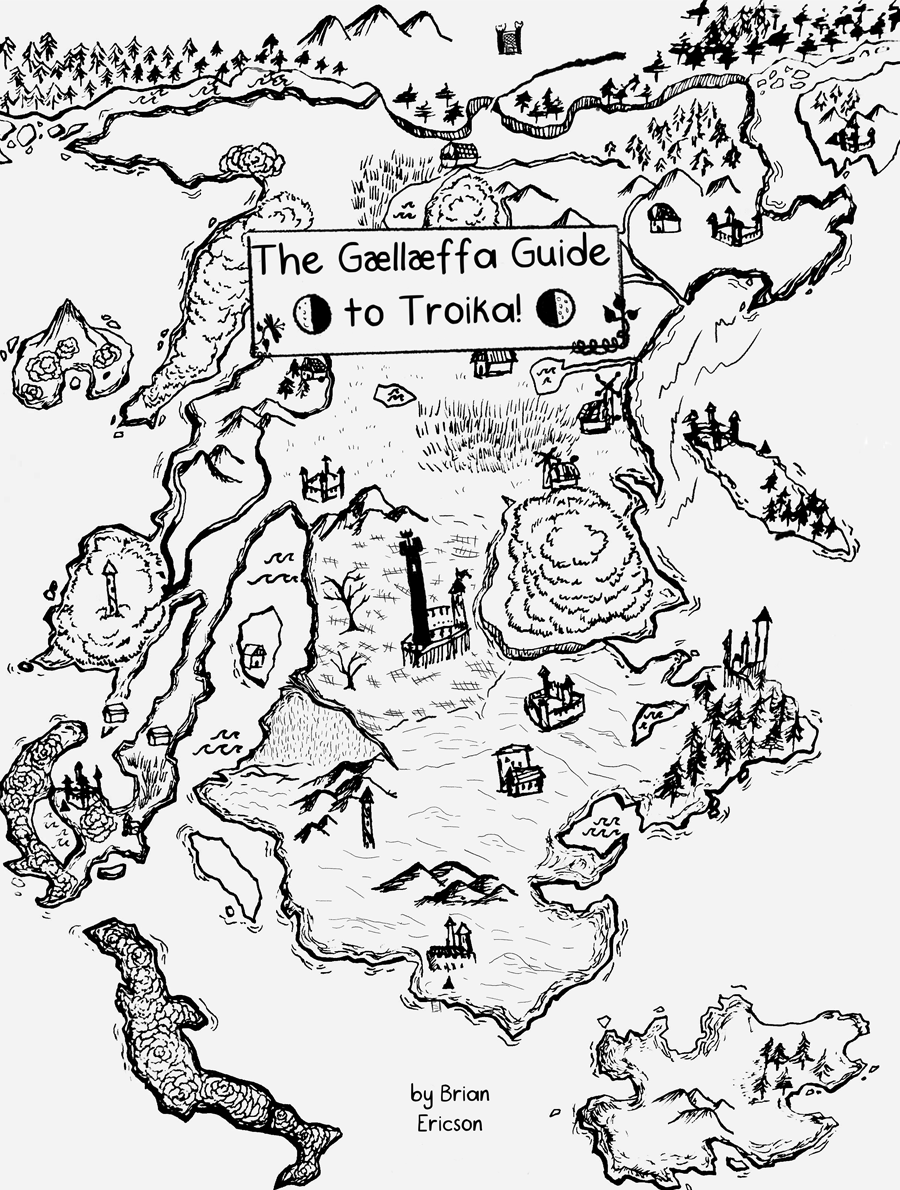
Created by Brian Ericson.
This thing is a zine in name only, and the cover is the sneakiest part. While the cover is a nice little map sketch, the interior is packed with gorgeous artwork. Like a LOT of gorgeous artwork.
Most of the 48 pages is 36 Troika backgrounds (kinda like classes). Like the Troika corebook, these backgrounds pull triple duty as cool character classes, NPC templates, and world-building details.
As an example, “Lampbearer of the Jet Strictures” implies a world where light is a valuable resources and those who control it wield considerable power. And that’s just 1 of the 36 backgrounds.
The rest of the book is some colorful monsters, a list of 216 random items. Each one is simple, but again, tells you a lot about its world.
It’s brilliant and colorful and inspiring. Don’t let the simple cover fool you; this is a brilliant world in a travel-size package.
Gardens of Ynn Permalink
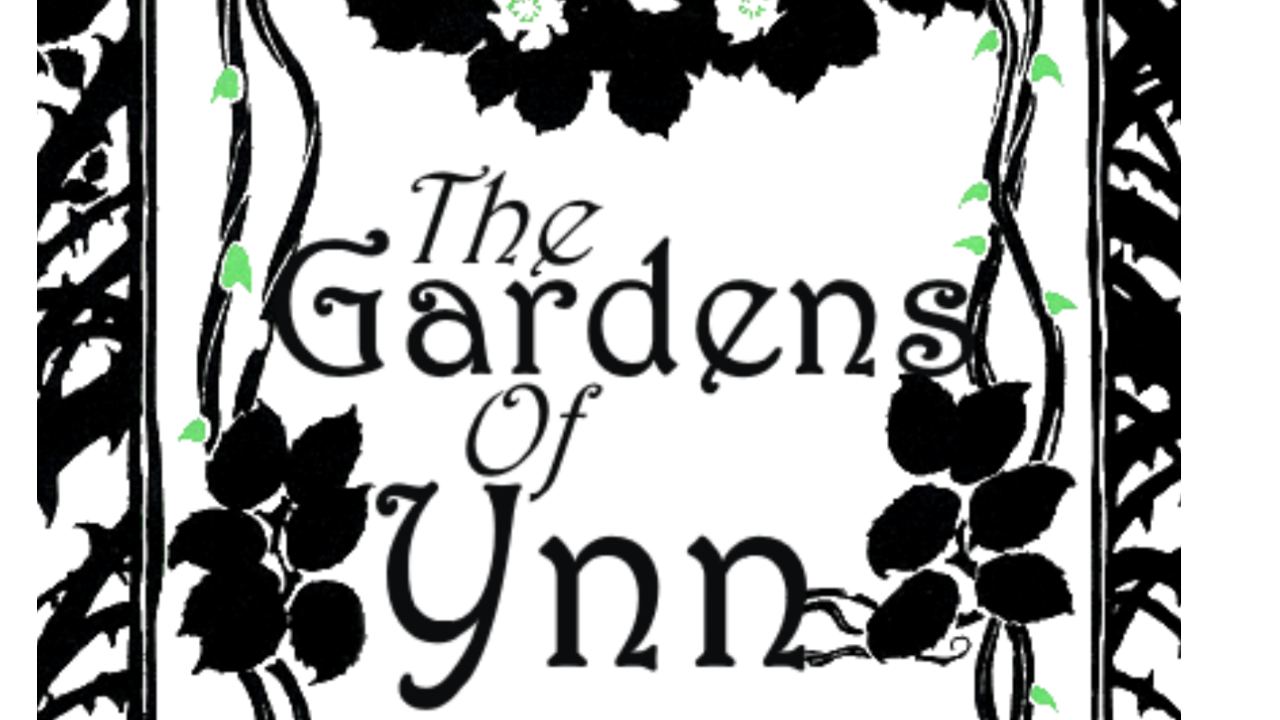
Written by Emmy “Cavegirl” Allen
The Gardens of Ynn is a point-crawl adventure set in an ever-shifting extradimensional garden. Each expodition generates its route as it explores, resulting in new vistas being unlocked with every visit.
I bought Ynn about a year ago and thought “Wow this looks cool. I really should sit down and read it.” 10 months later “Oh hey! I almost forgot about Ynn.” And now I sorely regret not reading it sooner.
This book is a master-class on evocative details that impact the game. This is something I’ve REALLY struggled with while writing Bone Marshes.
“The hot room causes d6-3 damage per turn” is mechanically sound, but very boring. “The sweltering heat burns your eyes and makes every cell in your body scream for water” is very evocative, but how do I communicate that through the gameplay? Here’s how Emmy handles that:
At the bottom, liquid fire, something between molten metal and condensed plasma. Falling into the fire deals 2d6 damage a round. Merely being in the burning vapours coming off it deals 1 damage per round.
Brilliant. If you want evocative, fresh writing and bizarre, interesting gardens then you MUST grab a copy of Ynn. Especially for $3. This is so good and so cheap that it should be a CRIME!
After you’ve bough a copy you can use my Ynn Generator to help you come up with locations quickly.
Girl Underground Permalink
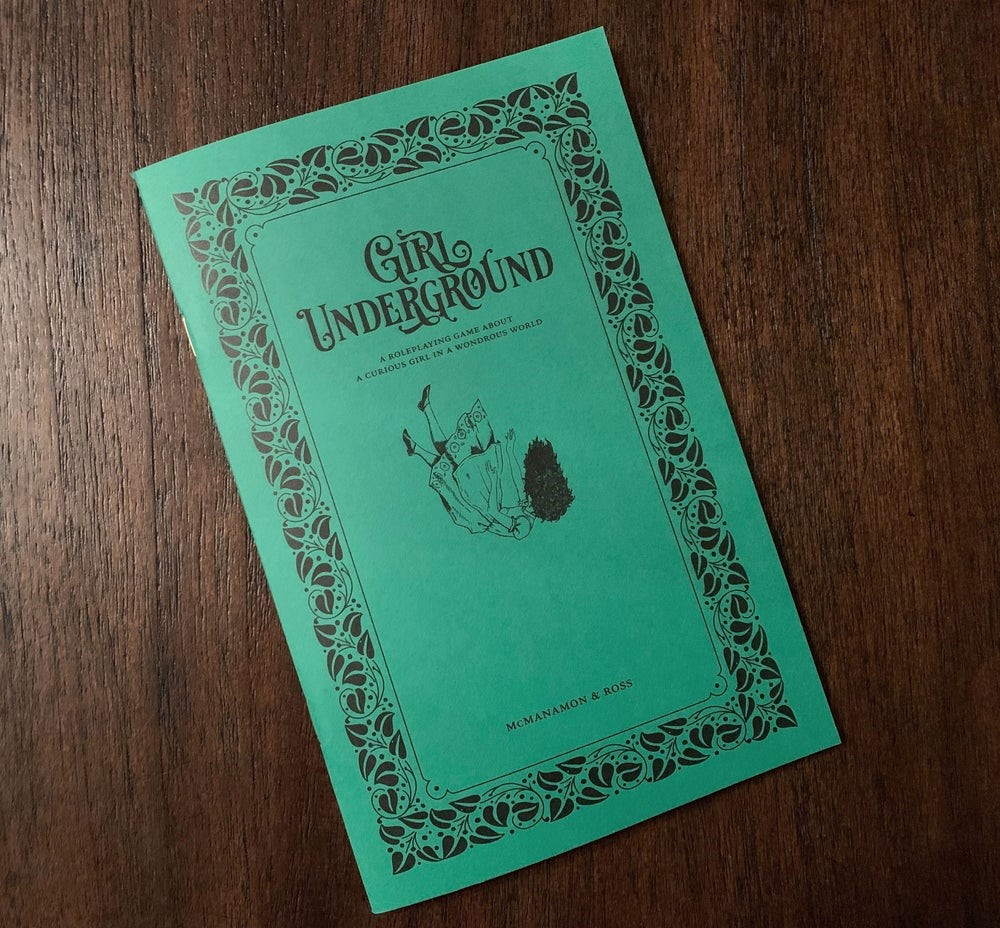
Created by Lauren McManamon and Jesse Ross.
Girl Underground made me cry. I don’t know if I could tell you why. But I hope that’s evidence of how sincere and well written it is.
On the surface it’s PbtA a game meant to evoke stories like Alice in Wonderland, Labyrinth, and Spirited away. Everyone takes turns playing as The Girl, as well as one of her companions. The GM sets the scenes and plays some of the NPCs in the world.
When you start playing you define a list of “Manners” that society expects young girls to adhere to. The girl will conquer these Manners over the course of the game, struggling against them or re-defining them to discover who she is and how her beliefs are shaped.
I struggle to say more without lessening the game itself. It is just beautiful, well written, imaginative, and it touched my heart. I’m sure it will resonate with yours as well.
Goblin Quest Permalink
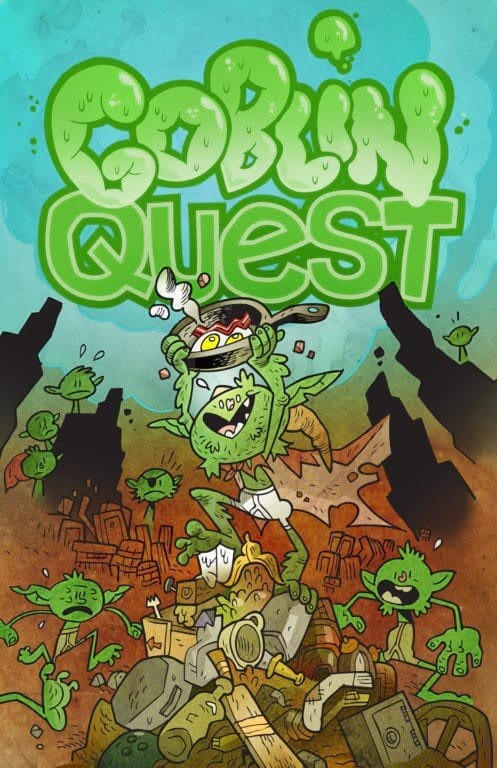
Created by Grant Howitt
Goblin Quest is a game that makes death fun, and has some of the most humorous writing since Baron Munchausen. The artwork is also amazingly charming. Seriously, look at it!
The game itself is very simple and easy to get behind. Each player controls 5 goblins (one at a time), working together to accomplish some mundane mission: make breakfast, steal a wizard robe, catch a fairy, and so on. The problem is that goblins are prone to dying in horrible and unlikely ways (which is why you control 5 of them). You’re trying to roll some dice above a certain number whilst describing your cunning plans.
The game treats each mission like a heist, allowing players to plan each step of the mission. During each step players roll dice and can fail miserably. Failure means death. LOTS OF SILLY DEATHS! This is a fun game for silly/drunk adults, and the perfect game for silly/caffeinated kids. This is the kind of game that my 12-year old self wanted to play.
Gourmet Street Permalink

Created by John Gregory.
The zine kicks off with a d100 table of food specials, condiments, and drinks. More tables for vendor stalls, names, customers, and more. It really is substantial and evocative. I don’t know what “Jellied Shug Monkey” is…but I want some!
The book also includes several food related factions, delicious monsters, and a compact chase adventure about a couple of chefs trying to escape a dangerous city block.
The artwork and writing are both charming and fun. I honestly cannot wait to use some of this stuff in my next game.
Haunted Almanac Permalink
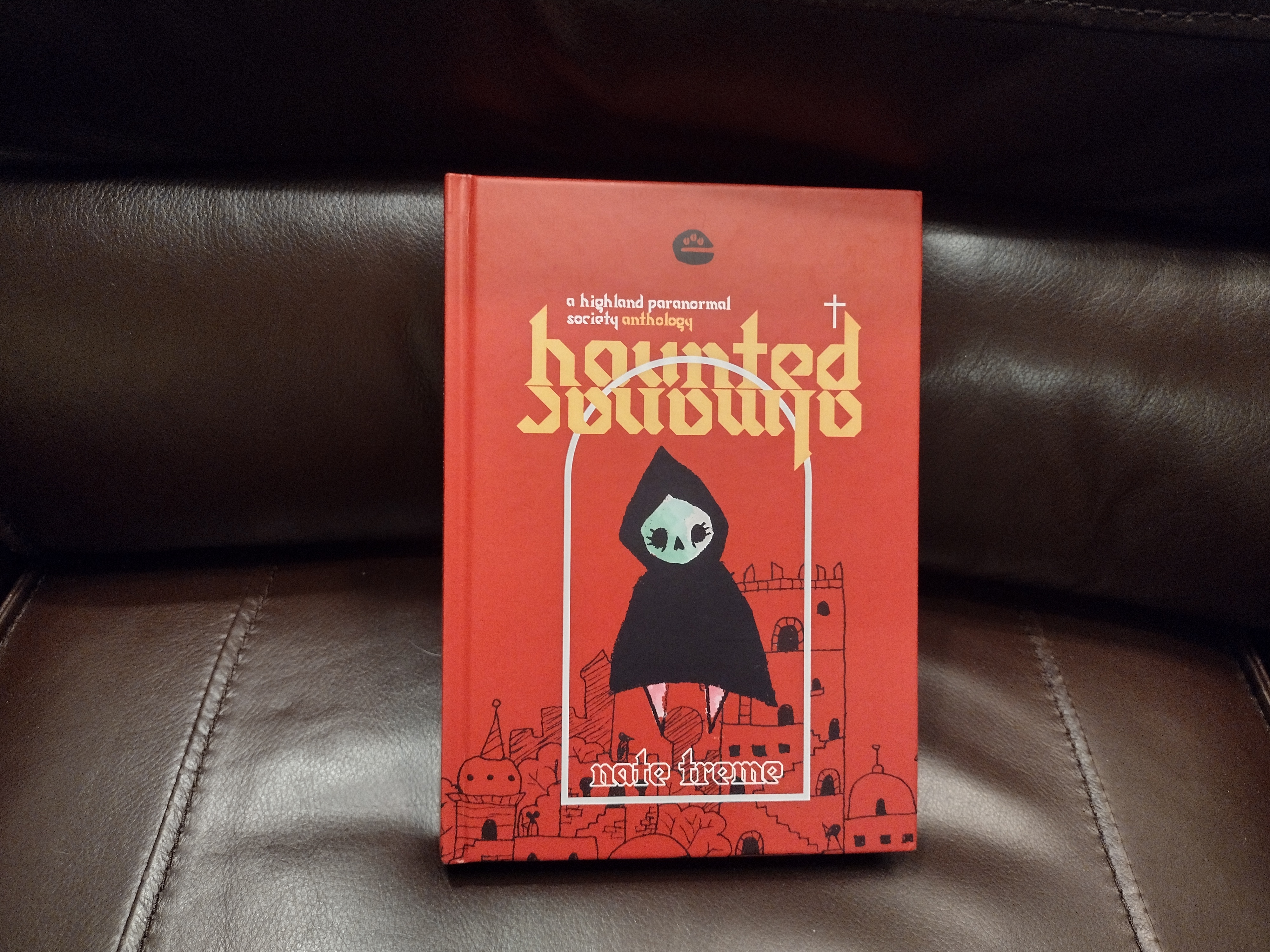
Created by Nate Treme
On his itch.io store Nate has over 40 products available: adventures, spells, NPCs, rules, bestiaries, OSR, lyric games, sci-fi, weird fantasy, steampunk, and everything in between. And that’s just on his Itch. As a long-time Patron of Nate’s, he is constantly releasing small, high-quality supplements that regularly impress and inspire me.
The man will not stop making cool shit.
However, it’s easy to listen to the little goblin in your brain and ignore his creations because of their small stature. Many rulebooks and adventures fit on a single page, or even a single business card.
He doesn’t make filler, of any kind, for any reason. You JUST get the good stuff. This creative strategy lets Nate completely finish a project and then move on to the next cool idea. He never gets stuck in one place, never stagnates, and continually surprises me with whatever he invents next.
Headspace Permalink
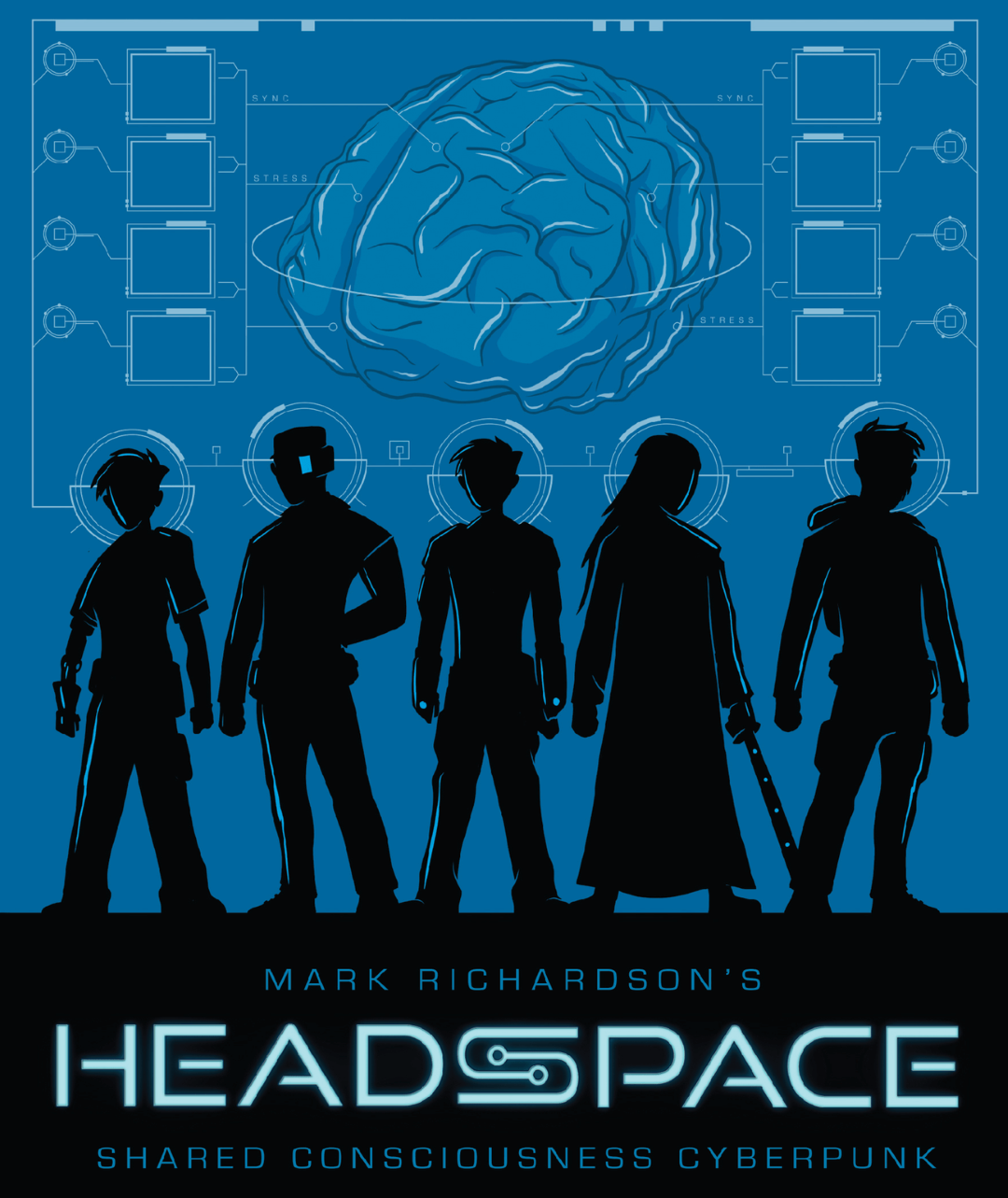
Created by Mark Richardson
Headspace is a Cyberpunk roleplaying game about hyper-competent operatives fighting personal battles against the Corporations controlling the world. The twist is that all the characters are connected with a neural link. The upside is that one character can access someone else’s hacking abilities, or precision shooting. The downside is that emotions bleed over along with skills.
As emotions bleed over and the tension rises, things start going wrong. A character may act out in fear and endanger the mission, causing even more stress. Headspace preserves all the fantastic cyberpunk trappings we know and love, and adds another layer of emotional processing that makes it uniquely engaging. I’ve never played a game that handles this so well.
The biggest benefit is the structure of the game, particularly the way the character sheets are designed. Everything is clear and easy to follow, with markers and trackers helping the table stay on the same page. It actually resembles some kind of strange board game which supports the more traditional RPG elements.
Lots of really neat stuff going on here, and worth a look if you’re into cyberpunk action OR an interesting dive into handling emotions.
Heart of the Atom Isa Permalink
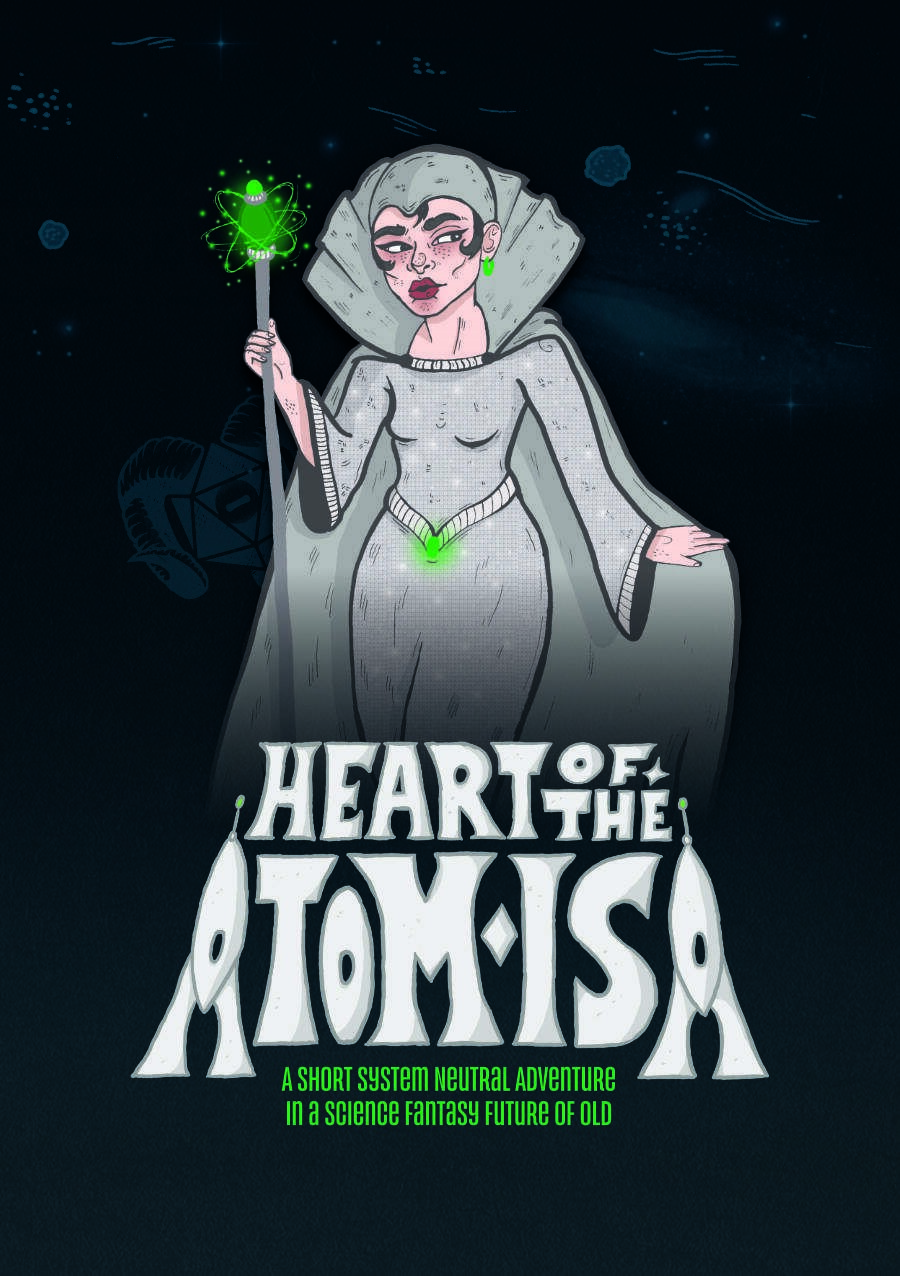
Created by Mottokrosh Machinations.
This adventure is OFFENSIVELY underpriced. Seriously, Mottokrosh?
$3 gets you 24 pages of flavorful pulp sci-fi adventure with incredible layout and evocative artwork. You can see a preview on the link above and judge for yourself how beutiful the book is.
It details 3 adventure locations, NPCs, adventure hooks, a villain, and more! I’m impressed how much creativity is exemplified in such a tropey, cliched setting.
It’s worth checking out even if you don’t like the cheesy sci-fi vibe, and could be mined for use in any game that doesn’t take itself too seriously. And again, it’s $3 and a crime against capitalism.
Hot Springs Island Permalink
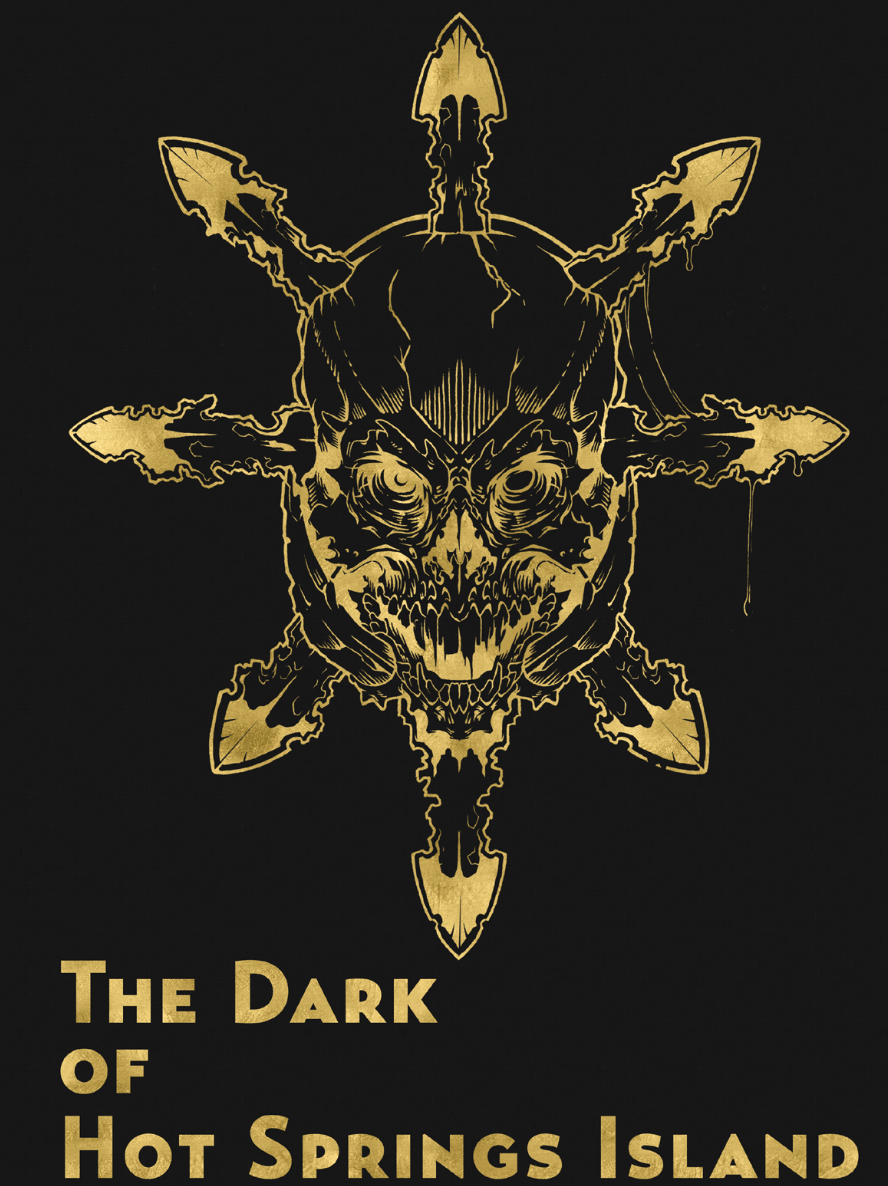
Player Guide PDF: $15 / Print: $40
GM Book PDF: $15 / Print: $60
Written by Jacob Hurst
Completely system neutral
Hot Springs Island, a new adventure from Jacob Hurst, is alive.
I don’t mean the books are alive, although they look sharp enough to cut somebody. I mean the fictional island feels like a living, breathing, screaming place. There are adventures out there with better stories, more interesting puzzles, or stranger creatures. But no adventure bleeds like Hot Springs Island. Read More…
Index Card RPG Permalink
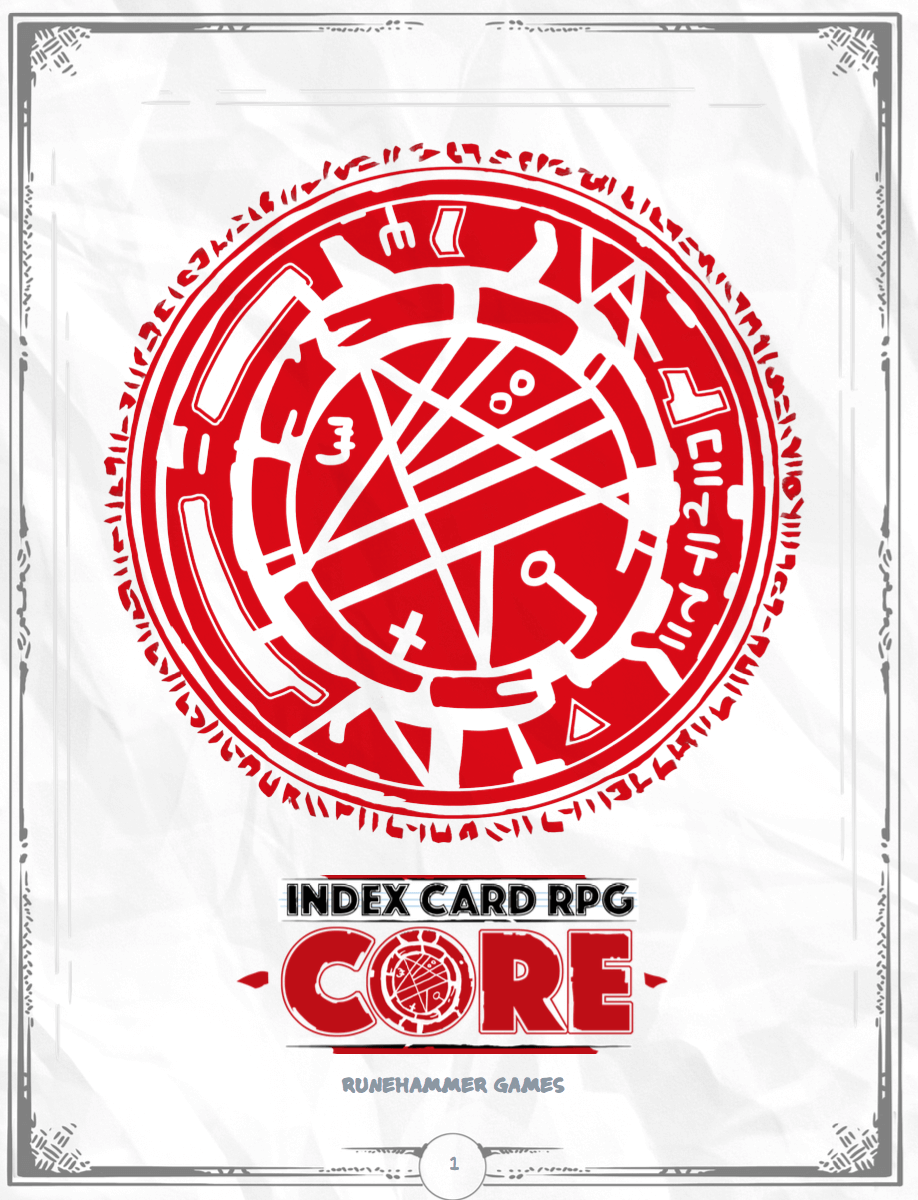
Created by Runehammer Games
So named because of its print-and-play nature, ICRPG came out about a year ago in a flurry of excitement and fantastic artwork.
Designed by Runehammer games, the same team behind Drunkens and Dragons, it’s a simple, lightweight rules system with modules for fantasy, sci-fi, horror, and western adventures. What really impresses me, however, is how well it plays online! Read More
Indie Hack Permalink
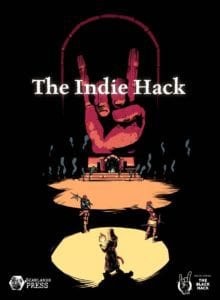
Created by Slade Stolar
After my review of Into the Odd, I find myself moving from story games to old-school systems. I couldn’t resist when Slade mentioned he was working on a game that combines the two! Similar to Dungeon World, The Indie Hack aims to simulate that classic DnD feel while keeping the flexibility of story games. However, The Indie Hack takes a completely different approach: Details Are Everything.
Whenever players interact with anything, they do this by adding/changing details. Hard details are drastic changes, soft details might be minor or temporary, and scene details can affect multiple things in the area. Attacking an enemy allows you to add details like Bleeding, Crippled. Disarmed, and so on. Objects and enemies can only contain so many negative details before they fall. So an enemy might have 5 “health”, and after 5 details are added, the creature falls to the ground, broken, bleeding, disarmed, insulted, and confused.
The variety of which details are added and how they are added keeps the game simple but engaging. A great choice for anyone who’s looking for something with low overhead but high flexibility. Two other mechanics worth mentioning. When you take a long rest, you can turn your injuries into scars, which add some neat flavor to the game.
But my other favorite idea is how relationships are handled. When someone tries to help you, you both roll dice. If their dice are better than yours, you accept their help, and your relationship grows stronger. Yay! But if their dice were worse than yours, you reject their assistance, and your relationship grows weaker. I just love the idea of someone trying to help pick a lock, but just gets in the way, frustrating the player who needed help. Brilliant!
Into the Wyrd and Wild Permalink
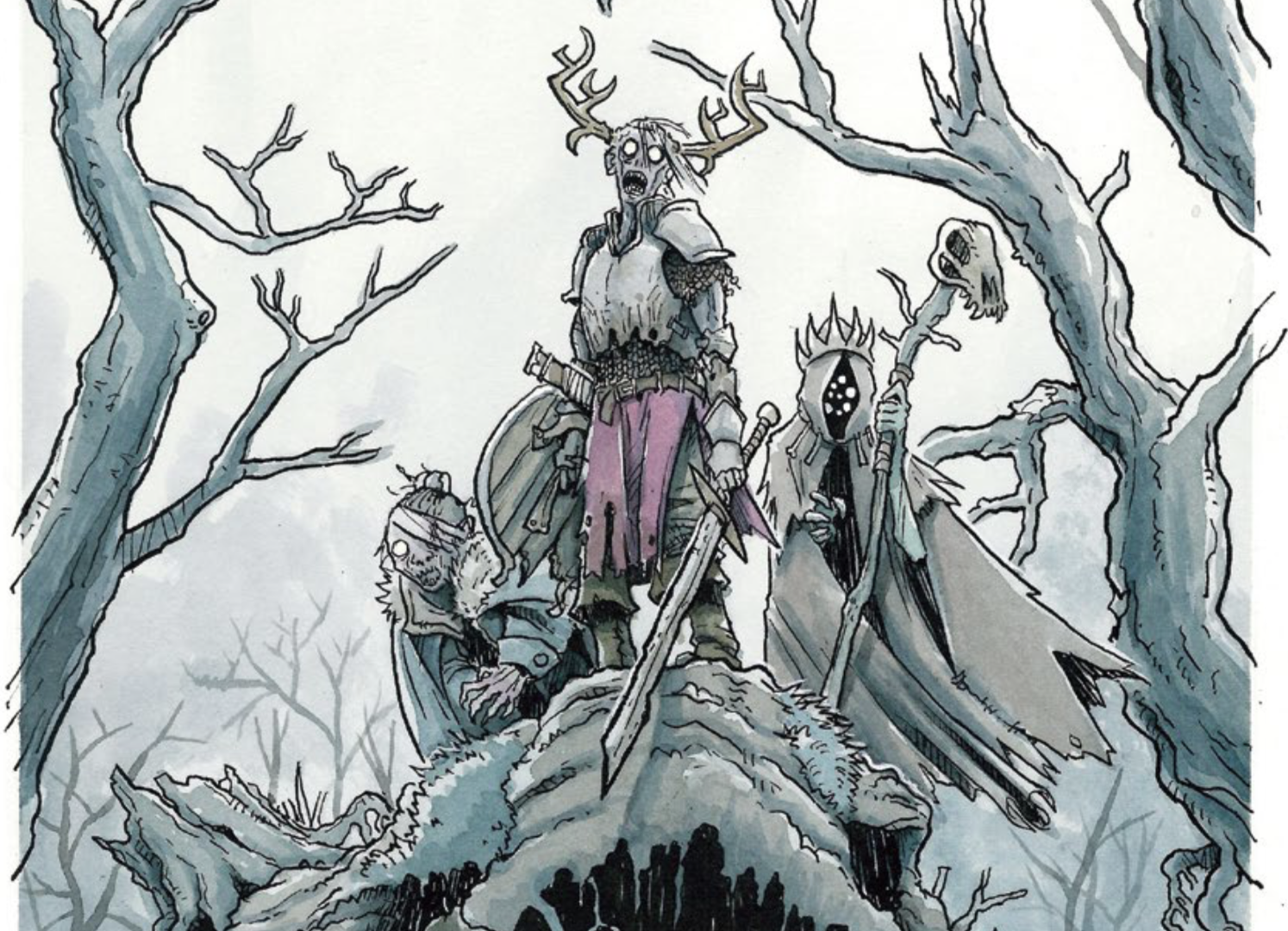
Created by Charles Ferguson-Avery
Whenever a product is advertised as a “toolbox” I grow suspicious. Because what they usually mean is “Here are some cool ideas, but you do the hard work of making it useful at the table.” Ugh. No. I need to be able to grab it, read it, and then jump into a game with as little prep as possible.
Into the Wyrd and Wild by Charles Ferguson-Avery is the first toolbox I’ve actually enjoyed using. Even though it did take a little effort, the result was worth it. 240 pages of grim forest content. Monsters, locations, descriptions, paths, traps, diseases, spells, items, and a framework for “Wilderness Dungeons”.
Inspectres Permalink
Created by Jared Sorensen
Often pitched as “The best Ghostbusters game”, this game does a lot of really clever things. It could easily handle a dark horror game, or a lighthearted silly ghost/pokemon mashup.
The main appeal, to me, is that you play as normal people. You set your stats and skills, but they never improve after that. The startup business is neat, offering a satisfying growth from nobody to big deal. Accomplishing missions earns you “cool” dice that you can spend to resist panic. Your franchise has Library, Gym, and Credit cards that can be used to add more dice to certain rolls. “Last night I spend 4 hours researching water-ghosts, so my library card gives me 2 extra dice.” A lot of little touches like these make you feel like a normal person trying to tackle things out of their league.
The other interesting feature is the play structure. Similar to Blades in the Dark, Inspectres has a structure built around jobs or missions. “Get the Call” -> “Research” -> “Suit Up” -> “FieldWork” -> “Cleanup” -> “Vacation”. Each stage has a few rolls, some random tables, and various outcomes. But they are simpler than Blades phases, so it keeps the mechanics from getting bloated.
Inspectres looks like a ton of fun and gives the GM a lot of great tools to run a supernatural game with everyday people.
Into the Odd Permalink
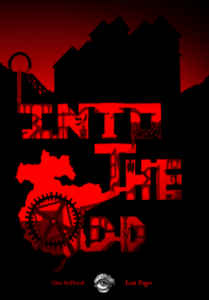
created by Chris McDowell
Into the Odd is a quick, simple system to facilitate dangerous and deadly dungeon crawls. The rules only take up a single page, and the rest of the book is random encounter tables, dungeons, advice, traps, magic items, loot, character generators, etc, etc.
Normally I HATE these kind of games. I don’t like putting my players in a situation where they will most likely fail, and I don’t like killing player characters. It just seems mean and cruel. I get no love out of torturing my group. Usually, I want to have a sweeping story, character growth, high adventure, etc. But there are 2 reasons why Into the Odd works so well for me:
1) Into the Odd has fast and interesting random character generation. My players didn’t mind having their characters die because their characters weren’t crafted with love and care. They were rolled up.This creates a fun detachment between player and character that keeps the deadly danger more fun than frustrating
2) Combat is lightning fast. I played this game with two regular pathfinder players, and it took a while to transition to Into the Odd. The big difference is that in combat, players and monsters only roll for damage. It’s assumed that players and enemies ALWAYS hit. This means that combat is more dangerous (since you’ll always take at least 1 damage); but combat is also more reliable. You know that you and your 3 friends won’t miss the monster. The question is: Can you kill it before it kills you?
These two facts ended up turning a dark and deadly dungeon into a sort of fun-house that players could throw their characters into and see what happened. It was a lot of fun, and I would definitely break it out again if my group wanted to have some murder-hobo adventures!
P.S. I made a fancy rules reference that you might find useful.
PRO-TIP: I printed out the Oddfield Survival Guide and made a small booklet for it. This set a really silly tone for the game that enhanced the funhouse aspect of my dungeon crawl. I HIGHLY recommend it.
Isle Permalink

Created by Luke Gearing.
My only complaint is that I found the adventure itself to be very grim. There are a lot of unpleasant rooms and minimal opportunities for rest or joy. This adventure is also very gross, in the same way that a gory B-movie is gross: quivering sphincters, squelching flesh, bloody mounds, etc.
I probably won’t run it (since I prefer a lighter beer-n-pretzels kind of game), but I could see a lot of groups really digging the vibes here.
The Isle is packed with clever encounters and creatures. A lot of monsters have ways they can be avoided or defeated outside of combat. Traps have multiple solutions. The rooms have many connections and secret passages. The entire thing just drips with smart design.
There’s a LOT of good stuff here, I just didn’t like the tone/vibes of the overall adventure.
With that out of the way, there are two things I am excited to talk about:
Knave Permalink
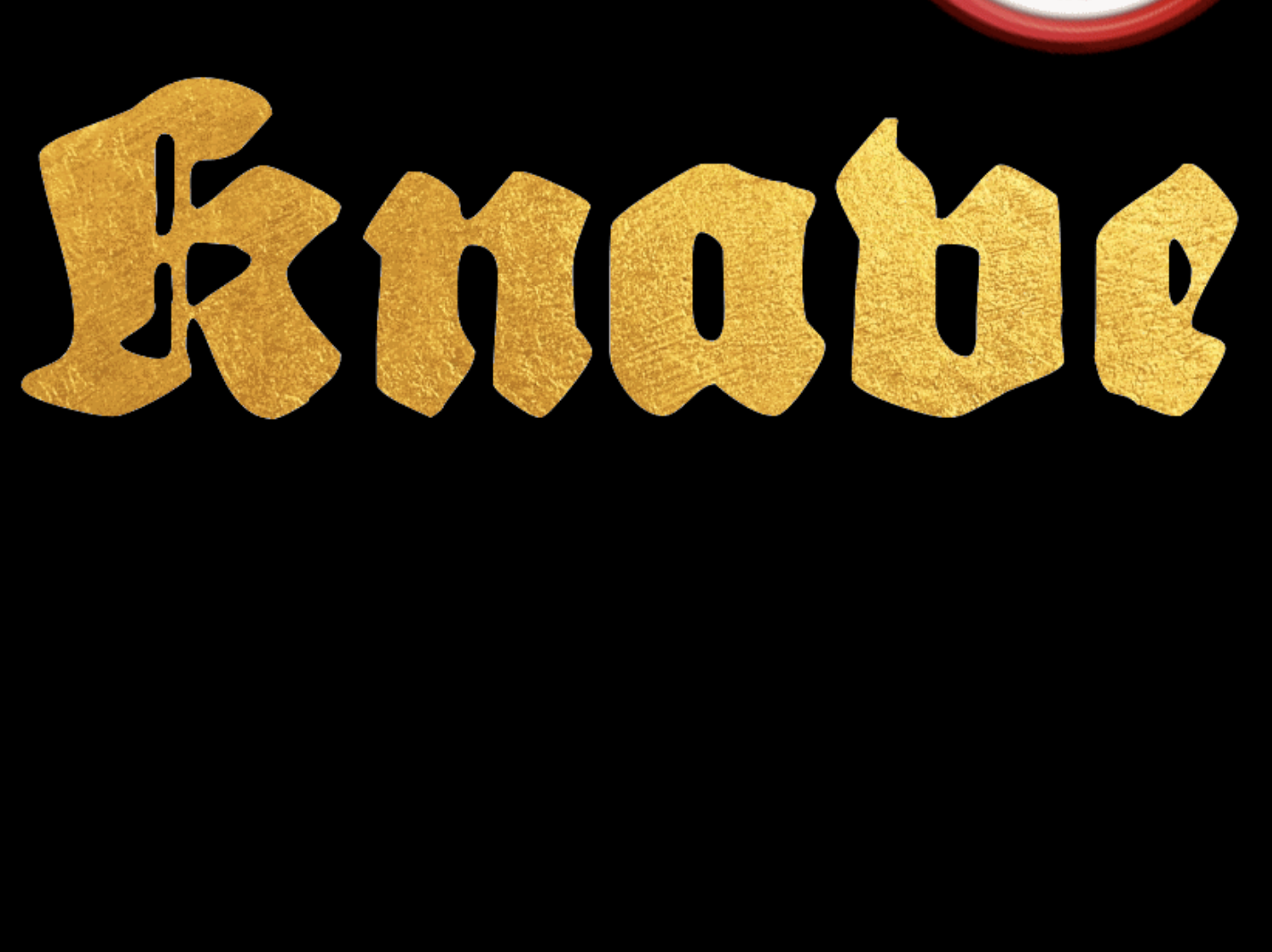
Created by Ben Milton
I didn’t really like Knave at the time…but now it’s become my go-to system for running older modules.
Built to be compatible with old modules while distilling the rules down to a smooth shine, it succeeds beautifullly!
Legend Permalink
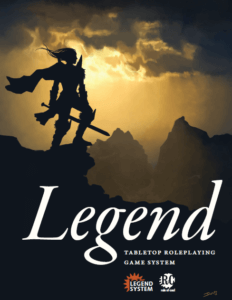
created by Rule of Cool
Legend was the first RPG that I ever played, and the longest campaign I ever ran! I’ve been meaning to review it for years, but finally had some free time. It was originally recommended to me as “Poor Man’s 4th Edition”. It delivers that, and more! While the combat is similar to 4th edition (multiple kinds of actions, grid-based combat, etc.) It’s the character creation that really shines.
To create a character, pick you race (6 choices), your class (8 choices) and then you pick 3 Tracks (3-5 tracks per class, plus a handful of extra Tracks). What’s cool is that each Track has 7 Circles, or Stages, each one granting different skills and abilities. Whenever you level up, you unlock the next circle from one of your Tracks.
This make character creation REALLY streamlined and clever. Instead of picking from a list of 30 abilities for the fighter, and 30 abilities for the Wizard, simply take the Fighter Track, and the Wizard Track. As you level up, you get the next abilities from each of those tracks. Some groups may find it too constraining, but not a lot of games this complex can create characters in 20 mins.
Definitely check it out if you like tactical combat. The game is finished, and a slightly updated version is buried in the forums somewhere. Sadly, future development has been halted, and no one has taken it back up. Shame.
Magical Industrial Revolution Permalink

Created by Skerples
Magical Industrial Revolution is a toolbox packed with steampunk magical content. The focus of this review will focus on “inspiration vs information”, and layout.
Magical Industrial Revolution has excellent presentation for fantastic inspirations.
Monster of the Week Permalink
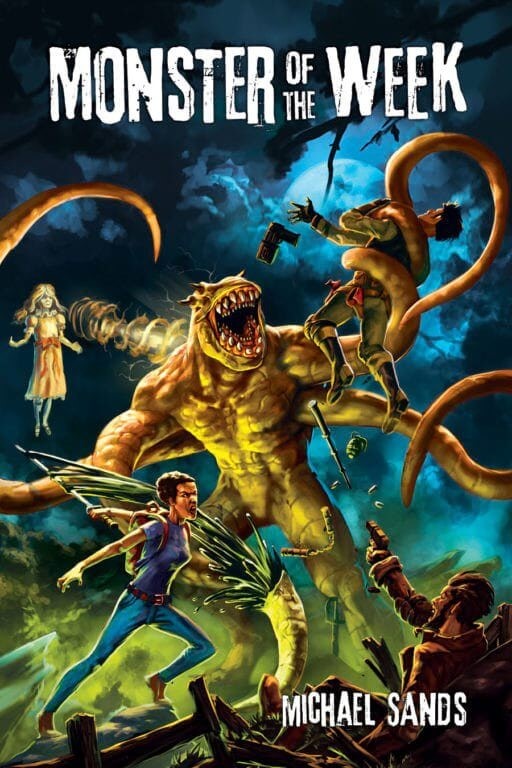
Created by Michael Sands
Monster of the week is a game where players take on the role of a group of modern day Monster Hunters a la Supernatural or Buffy. Michael Sands does a great job of explaining how to run a mystery game. The playbooks are well designed, with lots of neat abilities and roles (like The Chosen, The Professional, The Flake, etc). And of course, the Apocalypse World mechanics are rock solid.
What’s interesting is how the adventures are structured. Every adventure has a main monster, a big bad. This monster can be pursued in many ways, but can’t be defeated until the weakness is discovered. This results in a game mostly about players tracking down clues, finding leads, and trying to deduce the best way to take down the beast. The players are given lots of tools to hunt down clues, and the GM is given great advice about how to plant and lead players through a funhouse of monsters and mayhem.
Motobushido Permalink
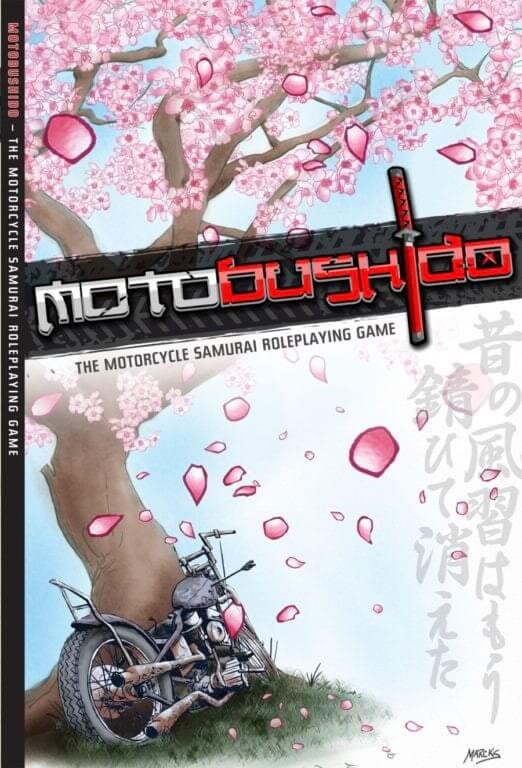
Created by Nathanael Cole
A game where you play as a clan of motorcycle riding samurai. It includes a modernized vision of Bushido and clan loyalty, which is really interesting.
The game is front-loaded with a lot of information about the Bushido codes and laws that your pack (gang) will attempt to uphold. Rules like “No take-backs” so that once you say something you must stick to it. Character “classes” detail your role within the pack, as well as how you can increase your influence.
The game is played with a simple card system. Many pages are spent on combat and conflict, but they don’t describe complex rules as much as they guide the tone and the goals of these conflicts. Rarely is your goal to kill all who oppose you.
The book is gorgeous, and sells the tone of the game with just a few pages of artwork. The biggest danger to Motobushido was creating a game that could live up to such a great concept. In this, they succeeded admirably, and you are given all of the tools and guidance to be a modern day Ronin.
Magical Murder Mansion Permalink

Created by Skerples
Murder Mansion continues Skerple’s trend of excellence and provides a really FUNNY dungeon crawl experience. A lot of games have jokes or puns, but not many of them are actually funny. This one is. My players were laughing and sweating through the entire adventure.
Mysterious Menagerie of Doctor Orville Boros Permalink
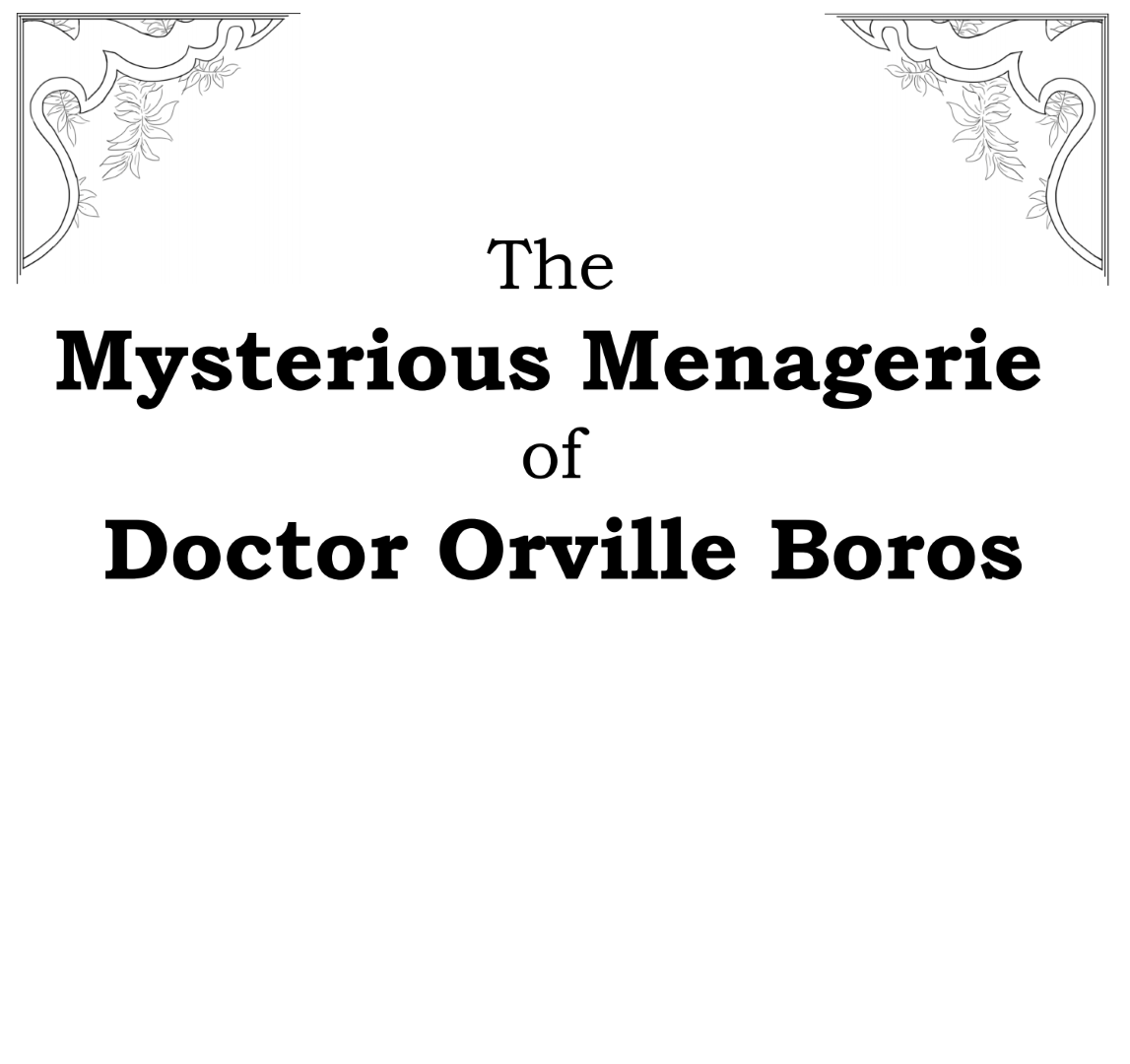
Created by Skerples
This is wildly creative, outrageously fun, and 100% free. Buy it now.
Try to imagine Jurrasic Park as run by Willy Wonka with the humor of Douglas Adams.
The adventure begins with the PCs being invited to explore a theme park created by a an unstable genius. To quote my favorite part:
The Menagerie was not designed to handle typical human behavior. If the PCs kill, mind control, intimidate, or otherwise neutralize all rivals AND keep their hands to themselves AND listen politely to the Doctor’s tour then nothing goes wrong.
Almost everything in the Menagerie is unsafe, precariously balanced, or fragile. In summary, if the PCs do anything they typically do when exploring a new area, or merely interact with the exhibits, Things Go Awry.
The adventure also includes SONGS that the GM sings at different parts of the adventure. If nothing else you should download this to read the “Fossils Song”. It’s a hoot.
This adventure is just everything I want from a fun-house dungeon adventure. My only complaint is that it’s a little too long for a one-shot.
Nova Praxis Permalink
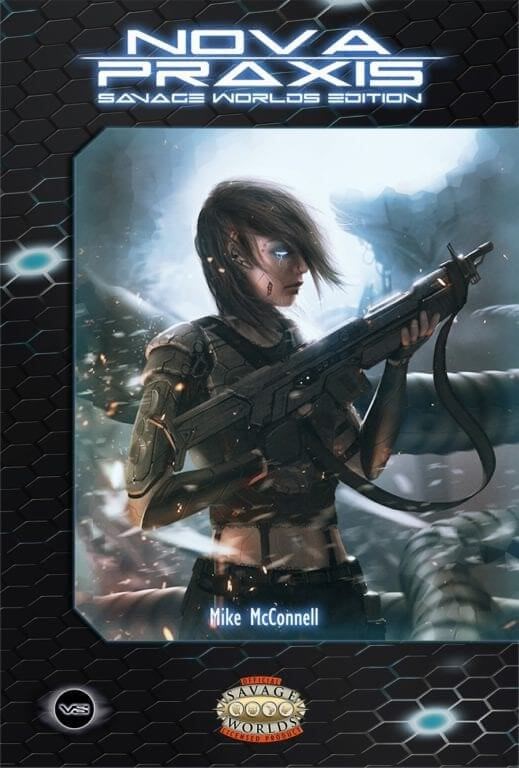
Created by Void Star Studios
Taking place in the far future, a “hard sci-fi” Post Scarcity and Post Singularity universe. Biotechnology, Nanotechnology, humanity is spread across the stars in various states of augmentation. This game has incredible world-building, and details how a post-scarcity economy works, how life has changed, and what concerns citizens of the future.
Explaining the universe could fill this blog, but if you like hard, well thought out science fiction, the backstory and setting are fantastic, well written, and very detailed. The game is available for both Savage Worlds and FATE.
The main reason it makes this list is the PDF formatting. They went above and beyond to make the PDF easy to navigate on a tablet. Bookmarks are along every page. It’s easy to jump to whatever section you need. I would like to see more games invest in their PDF versions.
Numenera Permalink
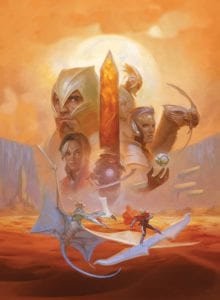
Created by Monte Cook
Numenera is the brainchild of famed Tabletop RPG writer and creator Monte Cook. The result is incredible, brilliant, and singular. Much like a movie with the same director, producer, and main actor, Numenera is Monte Cook inside and out; no filters from the publisher or printer. And it shows, in both the good ways and the bad.
The Good: The worldbuilding, universe detail, theme and setting are absolutely incredible! I’ve never read an RPG with such a rich world just begging to be explored. Every sentence in this book promises incredible people, places and adventures. Numenera is set millions of years in the future, in a world where humanity has lost its former glory, and explores the mysterious and powerful remnants of its past. The whole game is built around the idea of exploration and discovering incredible things; and for the most part, it does its job admirably, with one notable problem…
The Bad: For a game that is so focused on exploration and adventure, all of the player abilities, skills, and gizmos are heavily focused on combat. So much so that whenever I run the game, I prefer to use a different system (like Dungeon World) so that my players won’t feel so useless outside of combat. And the combat mechanics themselves are very reminiscent of 3.5 (which Monte Cook also designed.) This is not necessarily a bad thing, but I found them very obtuse and unsatisfying.
Numenera is the most beautiful world I’ve ever played in, and one that I will be coming back to again and again. The system, however, may not return to my table.
Parsely Permalink
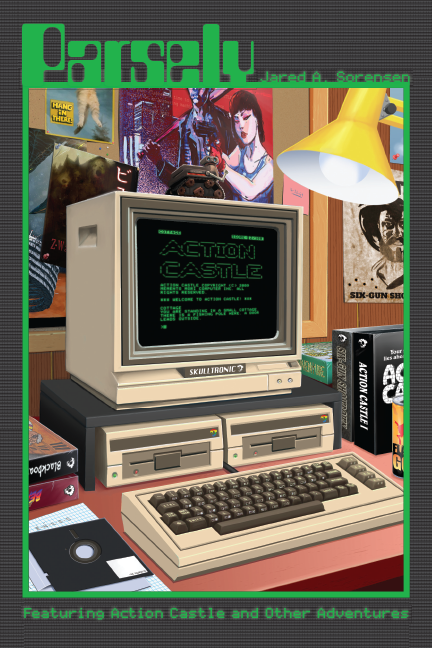
Created by Jared A. Sorensen
Parsely is a hardcover book that contains 12 adventures. Inspired by old computer text-based adventure games, Parsely is a like a D&D escape room party game. And it’s a damn good party game, y’all.
My wife and I have played these games during long road trips. But I’ve also run them for crowds of 20+ people. It was equally fun with almost any number of people.
It’s the kind of game best explained with words and gestures, rather than simple text. But I’ll try to demonstrate what Parsely is and why it’s fun.
PuppetLand Permalink
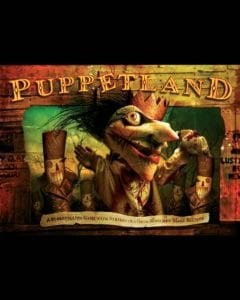
created by John Scott Tynes
This is a strange one, with a dark setting and unique emphasis on rules. You play as puppets set in the world of the Maker where no humans control you, and your strings are free. One bad puppet has killed the Maker and now rules the land with evil and power. You play a group of puppets who seek to kill him.
One of the things that struck me as interesting about the game are the Three Rules. The first is that games only last an hour. In fact the manual encourages you to keep a watch nearby, and limit yourself to hour-long sessions. The second is that players can only speak in character. Everything that is said comes from the mouth of the puppet, not the player. If a player must speak out of character, they have to stand up and signify that they are no longer in character. The third rule is that players and GM all contribute to the story, and it should be told as if in a play, not like recounting your grocery list.
I like to see games that limit themselves. Rather than say, “play until you get bored”, or “Here are rules for a tolkein setting”, it’s a show of confidence to express the limits of your game.
Quiet Year Permalink
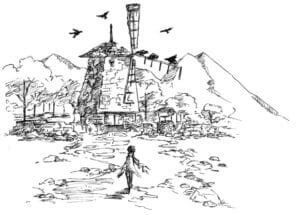
Created by Avery Adler
This is a community creation game. The group builds up a small town or village over the course of a year. The game is played week by week, where during every week a card is drawn, triggering a specific event, trouble, setback or discovery. Players work together to build a map, gather resources, and resolve problems that arise.
Wow. I don’t think I’ve ever played anything like this outside of a video game or board game. It works particularly well with groups that have new players, or don’t like combat. The cards as seasons mechanic is brilliant, and creates lots of anticipation for the next week. There’s a great table that gives you a good idea of how the weeks affect the game. Great way to spend an evening on something new and interesting.
Also, as an aside, when a game session is over, you will have a fully fleshed out town with history, culture, and nearby geography. I took our first few resulting towns and used them in my Numenera and Dungeon World games. Cool creation tool.
Sailors on a Starless Sea Permalink
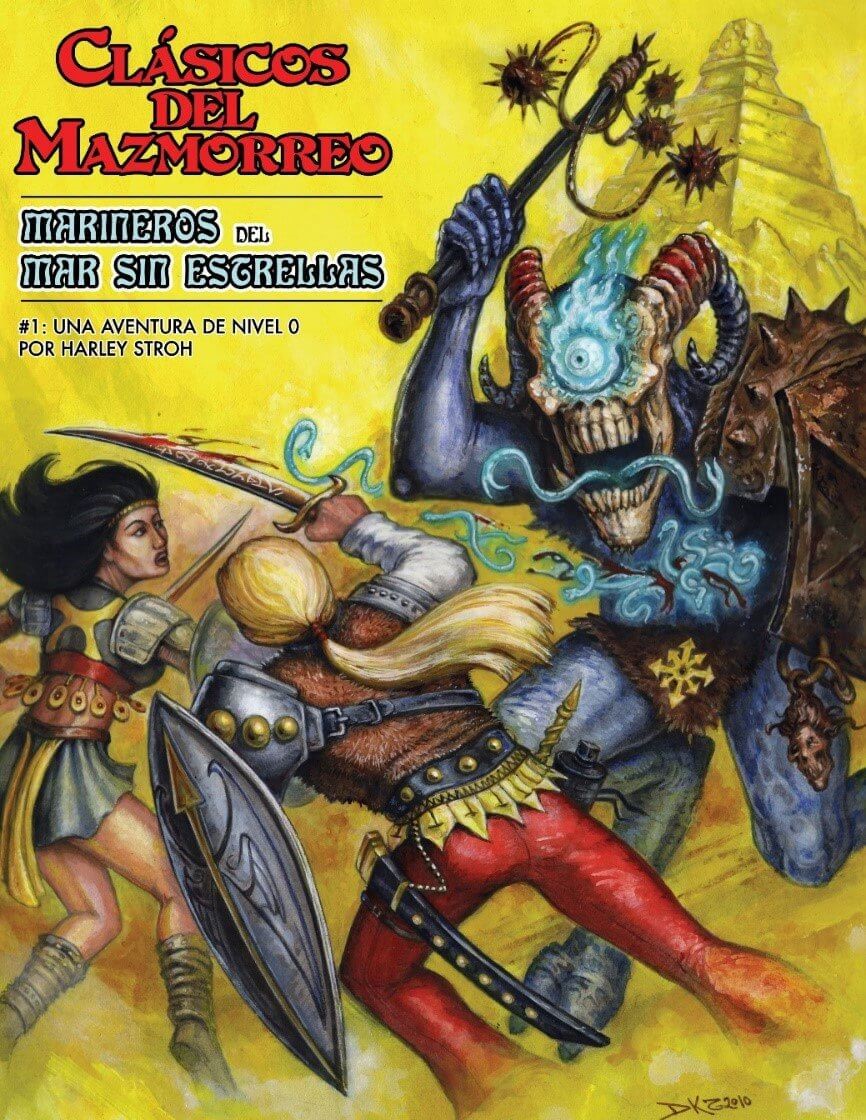
Written by Harley Stroh
Designed for Dungeon Crawl Classics
You awake to find your village burning. In your panic to put out the flames, it takes a few hours before you realize that only your small group remains…
This adventure is built as a “Funnel”. Each player generates 3-4 low-level villagers and you run this large group of characters through a dangerous meat-grinder adventure. Any characters that survive gain a level and pick a “real” class.
What’s neat about this adventure is how quickly things escalate. Villagers start out just looking for their friends and family, but by the end of this 4-hour adventure they are preventing the return of an ancient Dread Lord.
It’s also a nice way to keep the “My village burned down, so I became a Hero” backstory without it being a cliche. It unites the party with a common backstory and gives them feeling of place in this world. A fantastic way to start a DCC campaign.
Sea Queen Escapes Permalink
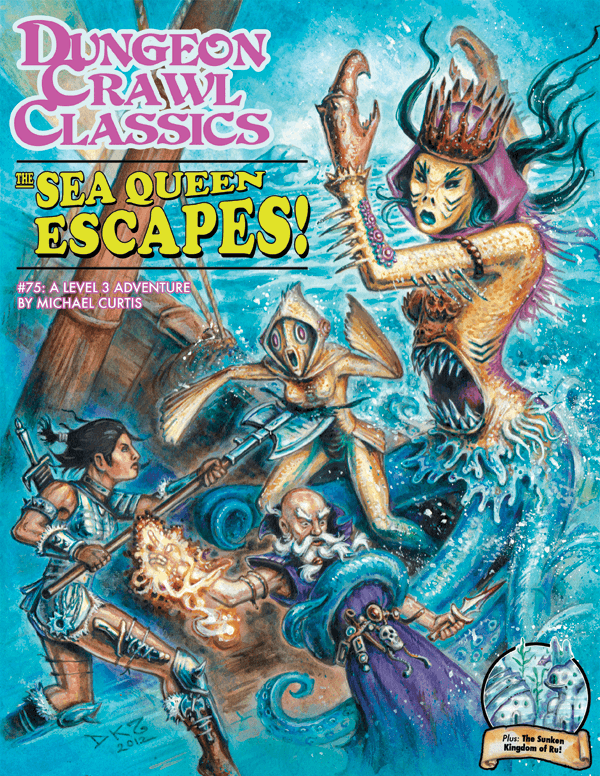
Written by Harley Stroh
Designed for Dungeon Crawl Classics
The characters begin to receive dreams about a trapped princess beneath the sea. If only someone could help her…
What’s interesting about this adventure is that it’s split into several small phases, each one like it’s own mini-dungeon. Since the dreams continue until the adventure is resolved, it works well as filler between a larger campaign. I usually mix it in with Tower of the Black Pearl.
Each phase is excellent and thematic; a solid mixture of puzzles and combat. Players go from exploring a seaside cavern, to delving inside a turtle, and finally an ancient underwater prison.
Even better, once the adventure concludes the players are thanked by an underwater race and invited to visit. A simple hex-crawl is included and could form the bones of many more adventures.
Servants of the Cinder Queen Permalink
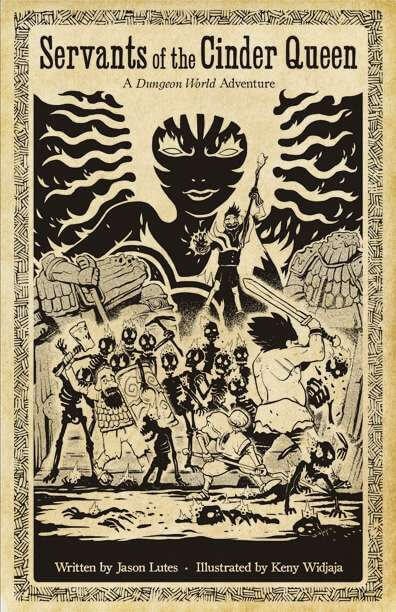
Written by Jason Lutes
Designed for Dungeon World
A volcano cult is attempting to summon an ancient evil, endangering the innocent town below…
Built for Dungeon World, Cinder Queen is remarkable for it’s adventure structure. Each room/area is not described in detail but with impressions.
Here’s a traditional room description:
“This large room is ringed with torches along the edge with a deep pool in the southwest corner. Every few hours a priest comes in and feeds the dangerous creature living in the pool. One of the torches near the water can be wielded as a Rod of Flame.”
compared to Cinder Queen:
Impressions:
- Ringed with Torches
- Deep pool with dangerous creature
Discoveries:
- One torch is actually a Rod of Flame
When players enter the room, roll 2d6:
- On a 10+ the priest is here, but is intensely distracted with feeding the creature
- On a 7-9 the priest is not here
- On a 6- the priest is just about to enter the room
Not only does this make each room easy to grasp, it gives the GM a lot of flexibility in how they describe the room. The layout in particular is really nice for referencing at the table.
Shadows of Esteren Permalink
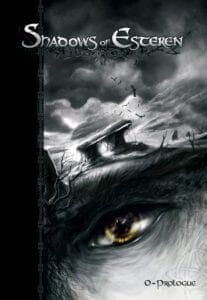
created by Agate RPG
Book zero is available for free, and lays down the setting and basic mechanics for this system. Self-described as a dark, low-fantasy grim world where magic exists, but usually manifests in dark curses or shadowy specters. No wizards or elves here.
Instead of the traditional stats based character options, Esteren focuses on different aspects of a character’s personality, motivations, and goals. I like the idea that characters aren’t based around what they are most proficient at, but what they want, or how they solve problems. If two men are equal fighters, then it all comes down to personality, motivation, and dedication. How far will you go t accomplish your goal? Also, skills and feats are laid out in a large tree, allowing for branching paths of character customization, rather than picking from long lists of abilities.
Silent Titans Permalink
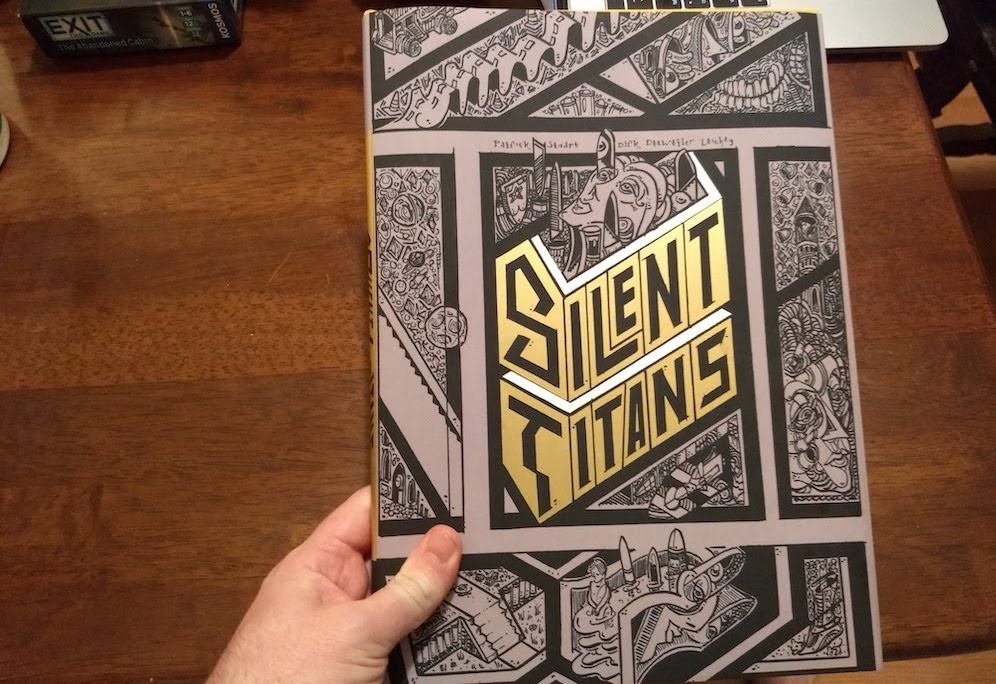
Written by Patrick Stuart, art by Dirk Leichty
Silent Titans actually works.
I originally bought this for the artwork. It’s gorgeous and unique and fresh and worth the price of the book all on it’s own. Go buy it now for a pretty thing on your bookshelf.
I’ve played a few “gonzo” D&D adventures and most of them were bad (with one brilliant exception).
At my table touchstones are important. Knights, goblins, druids, magic swords, and wizard towers are all cliche and have been done a thousand times. That’s why everyone knows them. And it makes my job as GM so much easier.
When I say “You see a black stone tower rising above the treetops with red smoke pouring from it” everyone gets the right idea in their heads. I know what they’re expecting and it’s easy to keep all the players on the same page.
The stranger something is, the harder it is to communicate without being boring or confusing.
Silent Titans is bizarre, freaky, and confusing as hell…but somehow it still works. How did Patrick Stuart pull that off? Read More…
Stars Without Number Permalink
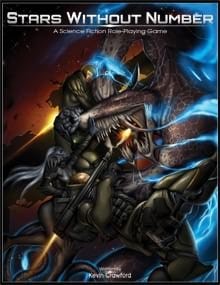
Created by Sine Nomine Publishing
A sci-fi role-playing game that portrays a universe where space travel has altered humanity over the course of generations. These mutations result in a groups of humanity manifesting psychic powers. After a horrible spacial anomaly kills all the psychics in the universe, humanity is recovering and re-building without the aid of interstellar travel. Worlds are stranded from each other, small leaders vie for power, star charts are mostly out of date, and tales of strange alien beings spread far and wide.
The OSR leaning is familiar to most gamers, and the sci-fi trappings work well with the ruleset. The main reason it’s on this list is the incredible generation tables.
Planets are generated with a atmosphere, temperature, population size, tech level, and so on. Star Systems, alien races, adventures, galactic factions, and more can all be rolled up and spread across the galaxy. Many games feature random generation tables, but Stars Without number does it extremely well with interesting results.
Strange Permalink
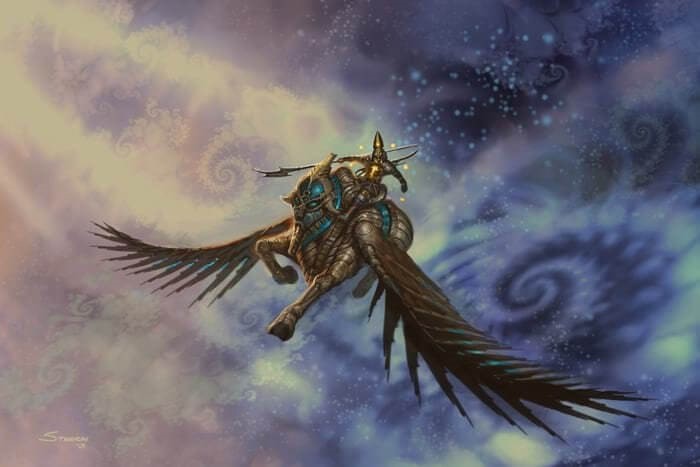
Created by Monte Cook and Bruce Cordell
The Strange is a game where the players are universe jumping secret agents. Set in a modern, FBI meets MIB type of world, Earth scientists have discovered a way to travel to other pocket universes anchored near Earth. Whenever players travel from one universe to another, they shift and change to adapt to the new universe (guns turn into spears, kevlar turns into plate armor, etc). This is a really neat concept, and gives the game a lot of promise.
It uses the same system as Numenera, although a lot more work has been done to expand the non-combat options. In general, I’d say that the Strange is much more mechanically sound and diverse when compared to Numenera. However, the Strange doesn’t have nearly the same appeal and incredible world building that Numenera does. Luckily, The Strange subverts that problem with this twist: there are basically infinite universes that players can visit, some of which are created by our own imaginations.
Want to solve crimes with Sherlock Holmes? Fight flying monkeys in Oz? Go for it! The bulk of the Strange is a toolbox for GMs and players to create their own pocket universes and worlds; keeping the same characters throughout their dimension-jumping adventures.
Stygian Garden of Abelia Prymm Permalink

Created by Red Moon Medicine Show
I played this one way before I heard about Gardens of Ynn, and I was excited to try something creepy and garden-y.
This adventure delivered a little more than that, at a slower pace than I expected.
The adventure is spread over a few locations:
- A multi-level manor overrun with spiders, goats, and statues; some of which come to life and some of which don’t. Your players will probably destroy them all just to be sure.
- A garden path with a dozen or so locations.
- A few smaller buildings and underground areas.
While there are a lot of interesting locations, things are fairly spread out. This is not an action-packed romp but a careful excavation of an abandoned property.
The maps are beautiful, and the players also get a version of the map without all the secrets and details, which is really cool!
I love all the neat plants as well. Instructions on what they do, how to cultivate them, etc.
Really fun adventure if you want a break from your garden variety dungeon crawl.
Stygian Library Permalink

Written by Emmy “Cavegirl” Allen
Remember the Gardens of Ynn? Just above this one? It’s like that, but LIBRARIES!
What more do you need to know? Why haven’t you bought this already?
After you’ve bough a copy you can use my Stygian Generator to help you come up with locations quickly.
Sun King’s Palage Permalink
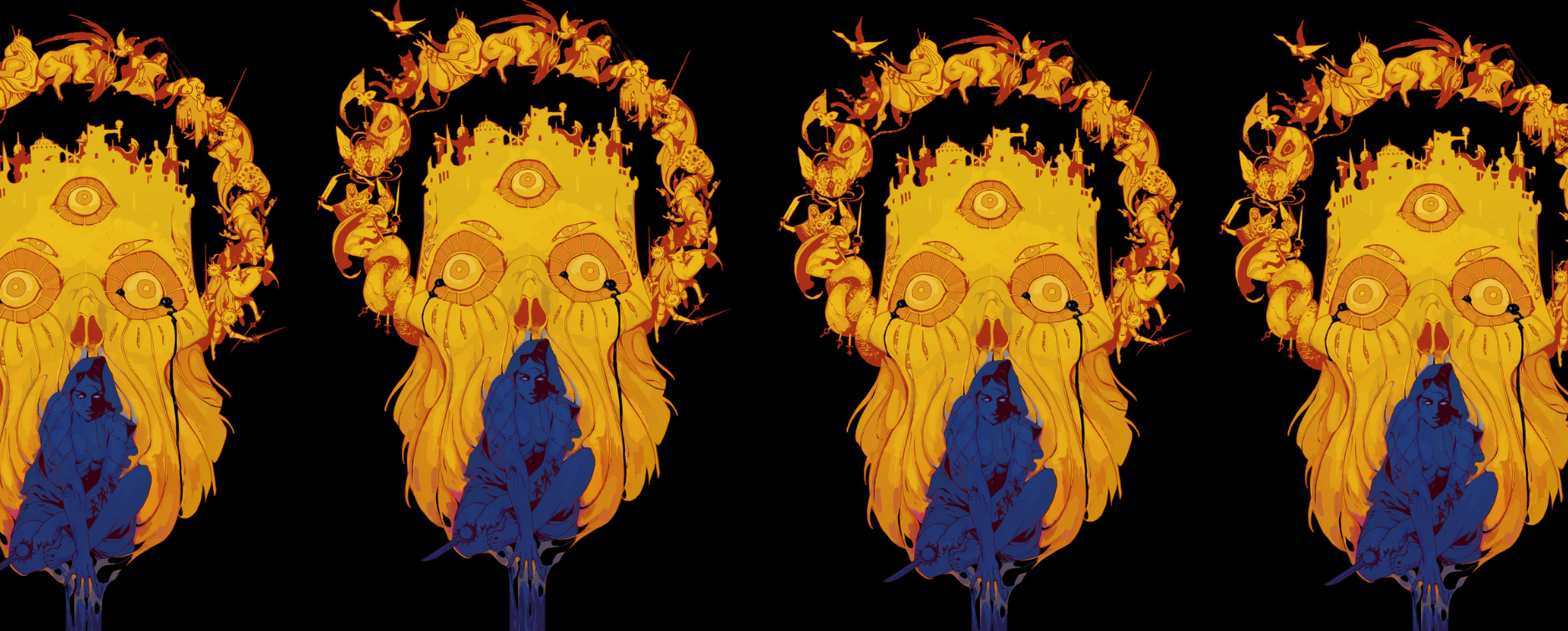
Created by John Battle.
I will say that the print copy is BEAUTIFUL and my preferred way to engage with the adventure. I started off reading the free version and fell in love enough to order the softcover.
It has a clean, beautiful layout that’s easy to navigate and digest. Each room takes up a page, each NPC and creature gets its own page, and there are lots of handy references. You WILL flip a lot of pages but you’ll never feel lost.
Definitely pick up a print copy if…*Read More.
Sunken Fort Permalink
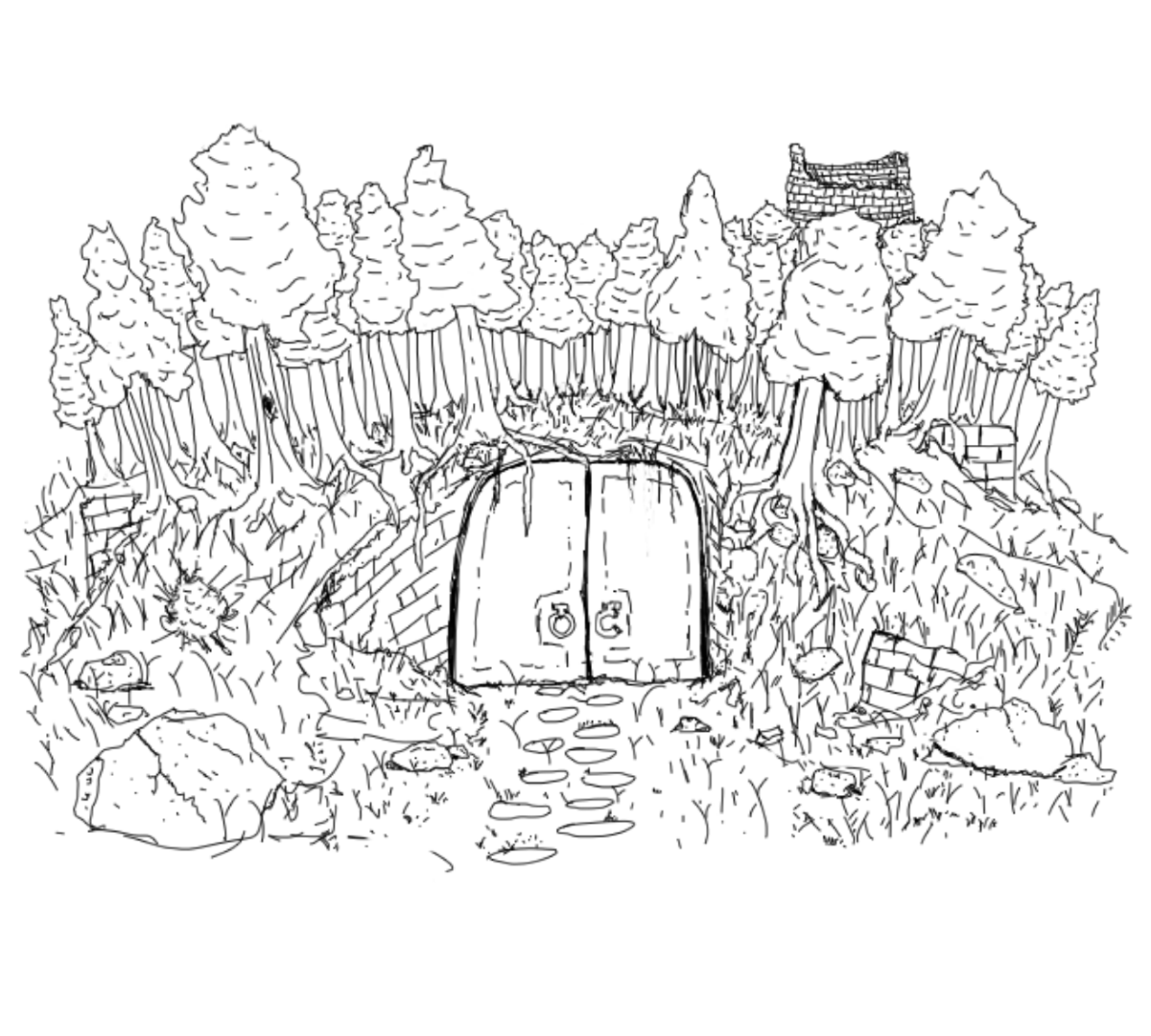
Created by Nickolas Zachary Brown
This 80 room dungeon starts off with a promis to the GM:
Preparation: None required!
And I was shocked to find it was true.
This thing really is a breeze to run. The rooms are well-explained and straightforward. Here’s an example room:
09: Two heavily armored figures spar in a small pit of sand with sword and shield. There are weapon racks around the room, with old decrepit weapons.
Armored Figures – (These are armored oozes who are focused on their spar, but will immediately attack the party as soon as they notice them being too loud or obnoxious.)
Weapon Racks – (Primarily hooks drilled into wall bricks. One such hook is attached to a loose brick, which if pulled out will reveal a piece of jewelry worth 500gp.)
ARMORED OOZE x 2 – Wield sword & shield
HD2+2 AC19 SPD9
*Upon Death: The black ooze will seep out of the armor, dead.
It’s so clean and clear. Filled with cleverly hidden treasure, ingenious traps, and probably too much oil, the Sunken Fort is a joy to play through.
But it’s an even bigger joy to GM. I put it up there with Hot Springs island in ease of use. And that is high praise indeed!
Synthicide Permalink
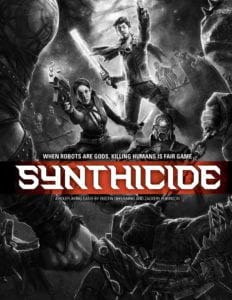
Created by Dustin DePenning
Kickstarted in October of 2016, Synthicide completely overwhelmed me on my first read-through. An absolutely gorgeous game, Synth is packed with player options, tactical combat, weapons, cybernetics, mutations, and more! There is a lot of interesting ideas here, but it struck me as “too complex for me.” I put it down, and walked away.
A bit later I came back to it. On my second read through, I discovered something wonderful: Synthicide is a broad game with a specific premise. In spite of all the rules and the “crunch”, each game starts the same way:
“Your group is on the run after committing a horrible atrocity: Murder of a holy automaton”.
What a great hook! This unites the group, gives them an on-going goal (escape/survive), and turns up the pressure. With this setup, I could see myself learning the game with my group. A tight premise like this one keeps the group and the game together. Everything is viewed through that lens. Ship rules can focus on how good ships are at running away or defending, rather than how to orchistrate massive fleet battles (because your criminals on the run probably won’t command an armada).
With that new focus, I had a lens to read the game, and was able to digest it much better. Synthicide is a great example of how important the initial premise is for pitching and playing your game.
They Cried Monster Permalink
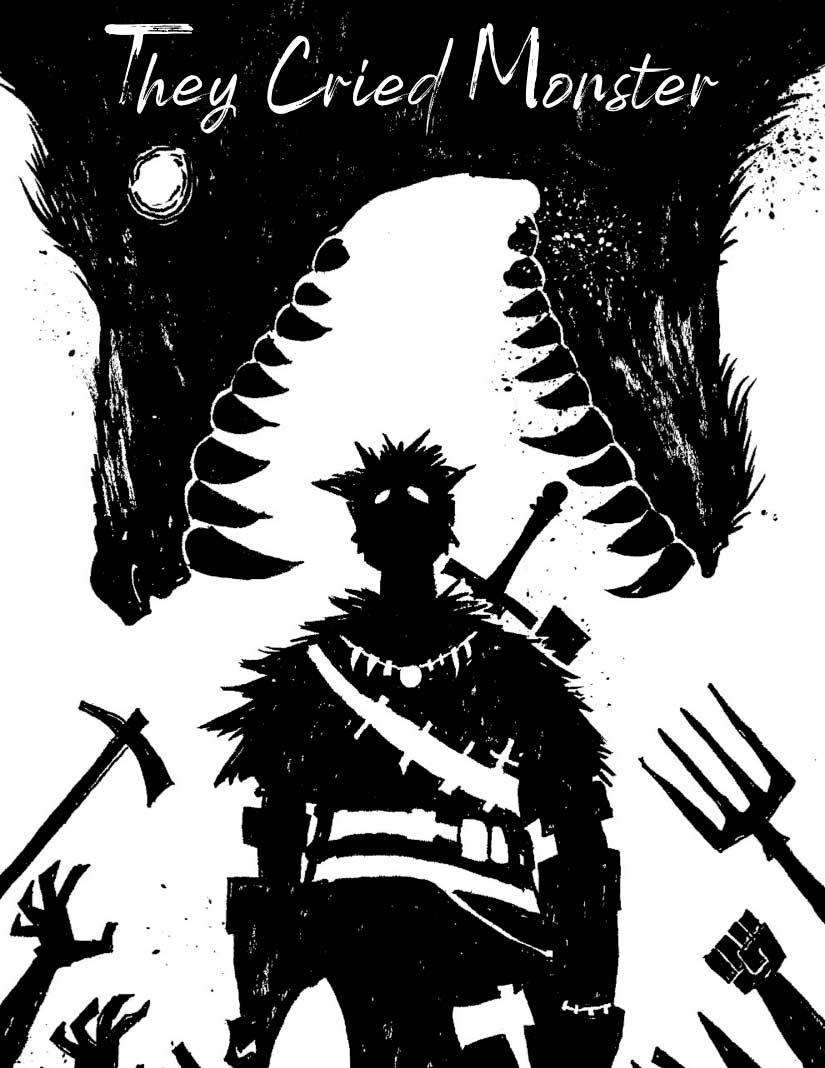
Created by Charles Ferguson-Avery.
“They Cried Monster” is an RPG zine that wears it’s Witcher inspiration on its sleeve. It’s beautiful art and presentation hide a tidy little monster hunt within it.
Most of the book is filled with generators for creating villages with a problem and 6 incredibly detailed monsters ready to hunt. The last little bit is filled with some clever rules.
It’s an obvious companion to Wyrd and Wild which is made by the same person! Or to say it another way: it’s an easy to recommend zine that pairs well with another huge book filled with flavorful monsters.
Definitely pick this one up if you have some aspiring monster hunters in your group.
To Stand Before the Dragon’s Wrath Permalink
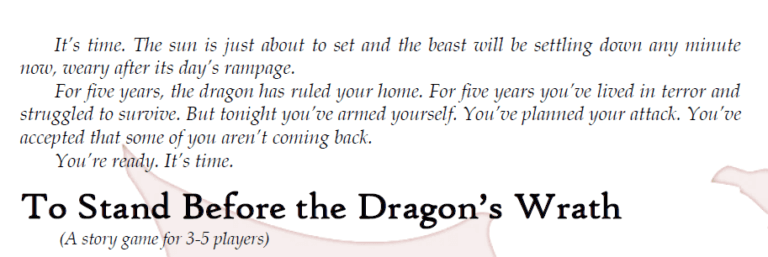
Created by Ed Turner
As a huge fan of small, focused RPGs I was delighted to find “Dragon’s Wrath”. Pitched as a short, one-short story game of death and defiance, Dragon’s Wrath is played with a deck of cards.
The rules span two pages, but have a lot of depth to them. One player plays as the dragon, the rest play as themselves. Five years ago a dragon came and ruled your town/county/area with cruelty. You will mount a defense against this terror, a defense surely doomed to fail.
The game is divided into 9 stages, and cards are drawn to determine who gains the upper hand at each stage. If the Dragon wins, they describe the details of that stage, and similar for the players. The dragon has powerful abilities to turn the tide, while the heroes can sacrifice themselves and (hopefully) secure victory.
I REALLY like the mechanics in this game, and it’s vivid story is just icing on a wonderful cake. Dragon’s is begging to be adapted and hacked, and I for one can’t wait to see what other games can do with this concept.
Tomb of the Serpent Kings Permalink
Written by Skerples
Designed for OSR systems
Recently uncovered, this tunnel underground may be the fabled tomb of the long-dead Serpent Kings!
I wish I had discovered this adventure earlier in my gaming career. Written as a teaching dungeon, Serpent Kings attempts to instruct your players on all of the traditional things found in a dungeon crawl.
Each room is designed with a lesson in mind, helpfully called out for the GM to read. “This room teaches you that dungeons have patterns that can be exploited.” “This room teaches you that dangers can often be avoided.” And so on.
If you are a new GM, or if you have new players, this is my number 1 recommended starting adventure.
Tower of the Black Pearl Permalink
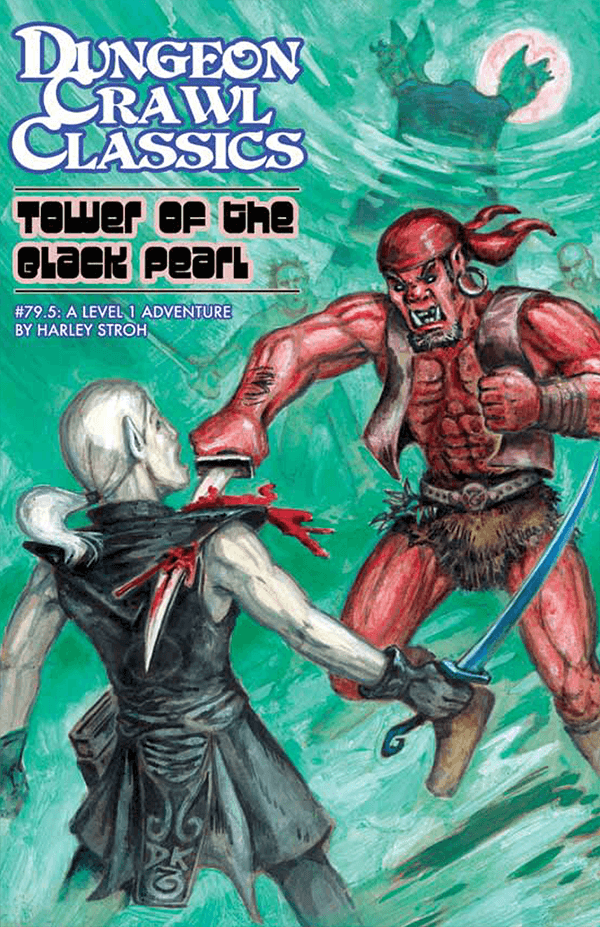
Written by Harley Stroh
Designed for Dungeon Crawl Classics
Once every 10 years the tides get low enough to reveal the top of an ancient submerged tower…
What’s cool about this adventure is that the tower is underwater; so the party enters at the top and slowly works their way down. Once they trigger an event near the end of the adventure the tower starts to fill with water, and it’s a race back up to the top!
Even if they make it through the tower, the stolen treasure is a powerful magical artifact that draws the attention of powerful entities. When I ran this, we had more trouble trying to sell the Pearl than we did getting it.
My favorite room is filled with candles, each representing a Hero. Players can interact with these candles, even finding their own brightly burning flames. If they go out for any reason, the equivalent heroes perish. I love to present level 1 players with opportunities to influence the world in serious ways.
It’s a really solid adventure set along the coast, and whenever my players get a hankering for swashbuckling, this is where we start.
Tower of the Stargazer Permalink
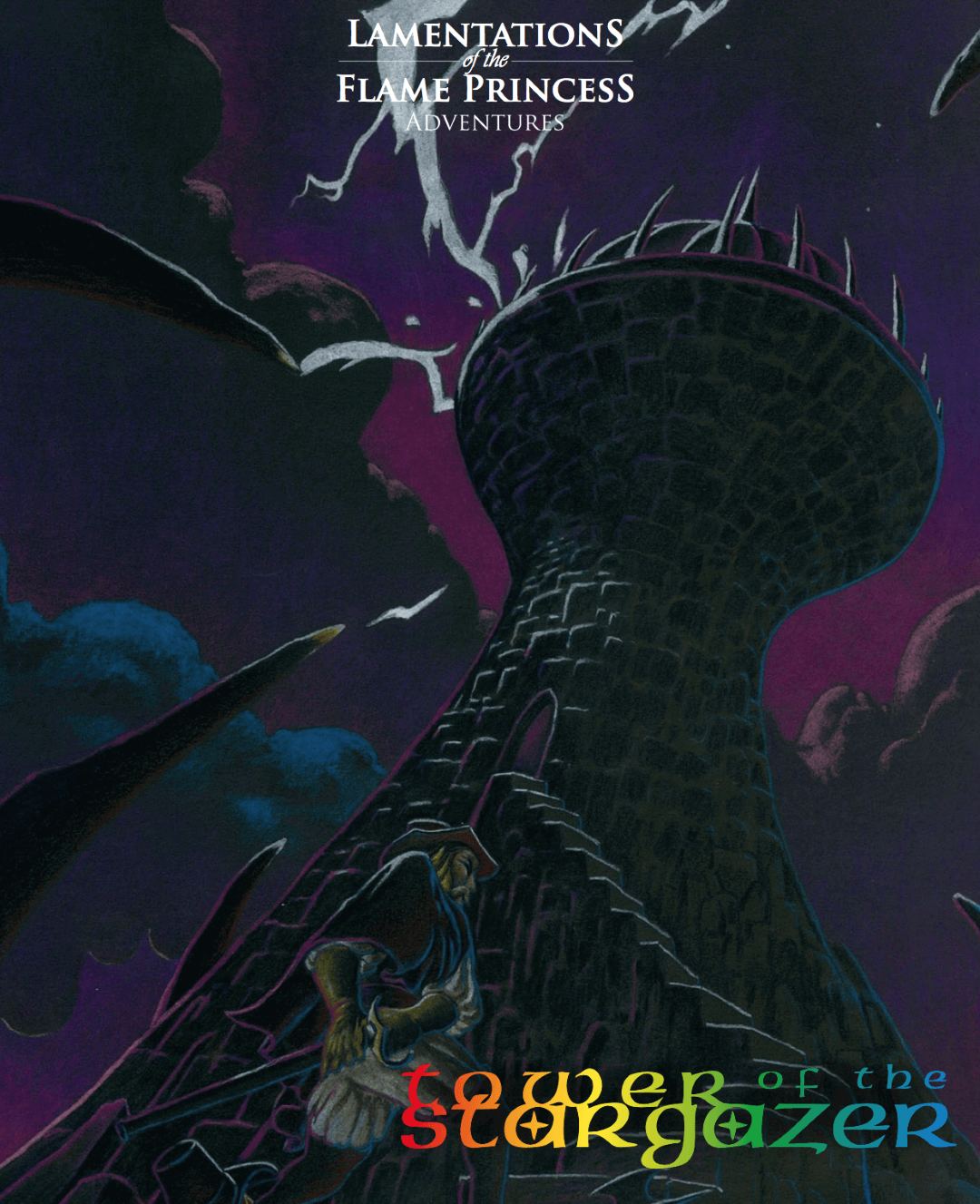
Written by James Edward Raggi IV
Designed for Lamentations of the Flame Princess
A mysterious black stone tower shrouded in lightening promises incredible mysteries and dangerous secrets…
I’ve never run an adventure that presented players with so many THINGS in it. Buttons, levers, strange contraptions and experiments abound. Many of the devices are described in detail, allowing players to experiment and discover their function.
The near-absence of monsters does not diminish this adventure in the slightest. In fact I’ve never seen an adventure maintain this kind of tension and engagement without regular monster encounters! Stargazer provides interesting rooms time and time again.
If you enjoy seeing your players slowly puzzle their way through a strange locale, you can’t do much better than Tower of the Stargazer.
Troika! Permalink
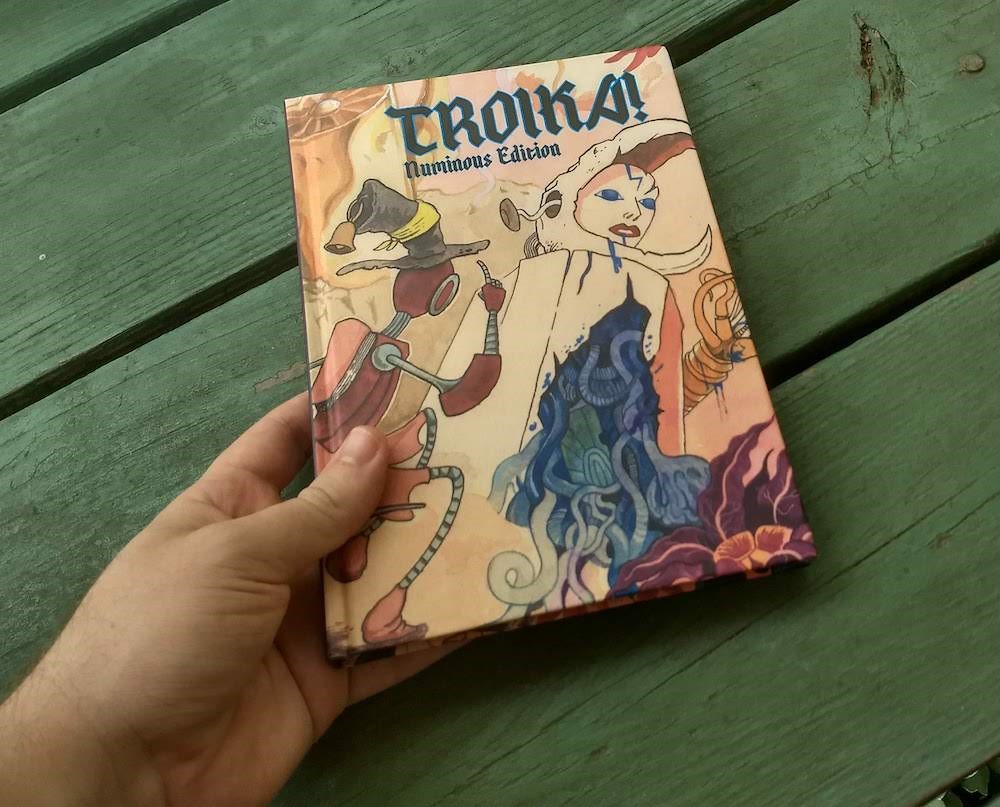
Created by Daniel Sell
Toika is really good. I’ve written and re-written this review several times, and i eventually settled on just rambling about why I like it. I hope you can follow the meandering nonsense.
So if you’re just looking for a review, Troika is a really interesting and fun RPG that provides a nice contrast to D&Dish games we see so much of. You should buy it. Be sure to get the physical copy if you can, because it’s VERY pretty and well-organized for use at the table.
TrollBabe Permalink
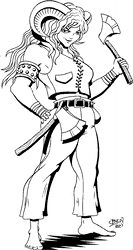
created by Adept Press
What a cool name. Trollbabe is about half human, half troll women who are magical and tough. Although they are at first feared or despised they usually end up being appreciated and respected. As the game that inspired Lasers and Feelings I was curious about how complex the rules would be. Turns out they aren’t much more complex than LaF, which surprised me.
Each Trollbabe has only one stat, their number. Rolling above, below, or equal to it lets you know how magical, tough, or charming they are. A simple, but elegant system.
The most impressive part of Trollbabe is the GM advice. Similar to Dungeon World, Trollbabe gives extensive GM advice. It reads almost like a textbook for telling a story. The rules cover pacing, the stakes of a story, possible outcomes, tonal consistency, adjudicating actions, and so on. Along with the explanations are simple graphs and outlines.
Having only skimmed the book for this review, I realize how much useful advice there is; and I look forward to taking a deeper dive and reviewing it later. Very impressive.
Ultraviolet Grasslands Permalink

Created by Luka Rejec.
I’ve struggled to review The Ultraviolet Grasslands. I posted a first look here, but anything I write out just seems to limit it. Is that weird? I think that’s weird.
My instinct is to share amazing screenshots of the art, but…you already know the art is amazing.
Maybe I’ll talk about the writing and the anti-canon setting that makes it your own…but Luka already did that!
Instead I’ll demonstrate how easy it is to prepared a game of UVG and how dense the ideas are in this book.
Unbound Permalink
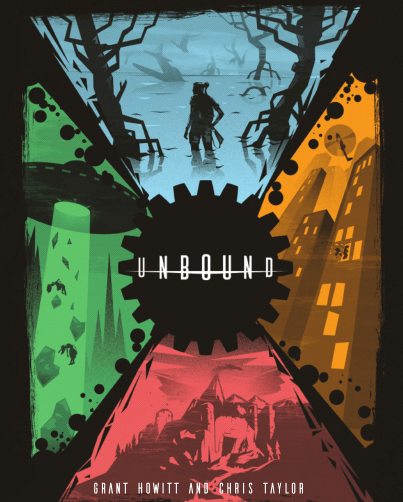
Created by Grant Howitt
Unbound is a new game by Grant Howitt (Goblin Quest, Warrior Poet). My favorite games from Grant have a silly, light-hearted tone to them that I simply cannot resist. Unbound breaks from that mold a bit.
Rather than a long review, let’s just cover some cool bits:
No setting, the group creates it together during the first session
Each player has a deck that represents their character. They write abilities directly on the cards to help remember which cards do what.
Combat doesn’t use a grid, but instead interconnected areas; REALLY cool implementation that I will steal for Mythic Mortals and Dungeon World.
Character’s HP is the cards in their deck. Cool to see more games simplifying HP and stats.
Lack of setting means character abilities and powers can be reskinned in many ways, giving WAY more variety.
The artwork is just gorgeous. I can’t get enough of it.
Definitely check this out if you like world-building and innovative combat mechanics.
Uncharted Worlds Permalink
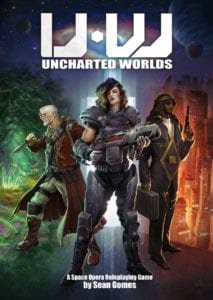
Created by Sean Gomes
Uncharted Worlds uses similar mechanics as Dungeon World, but with fantastic sci-fi rules and settings. Fast and easy to play, Uncharted Worlds brings two innovations that really grabbed me:
1) Character Creation. Players pick an origin (colonist, privileged, rustic, etc), and a career (academic, explorer, scoundrel, etc). Together these determine your stats and skills (with a little extra customization). This not only provides a backstory for your character, but also makes it a much more interesting process. Instead of picking skills and loadouts for playstyle purposes, you’re crafting your character from start to finish.
2) Ship Moves. Your ship not only acts as a base of operations, but can be piloted and controlled through special moves. Some characters can pilot the ship better than others, but the capabilities and status of your ship makes it another character in the game.
I can see this system working for everything from Firefly to Star Trek. Unlike Nova Praxis, Uncharted Worlds is easier to jump into and a lighter kind of Sci-Fi. I hope I get the chance to run a campaign with this system.
Vagabonds of Dyfed Permalink
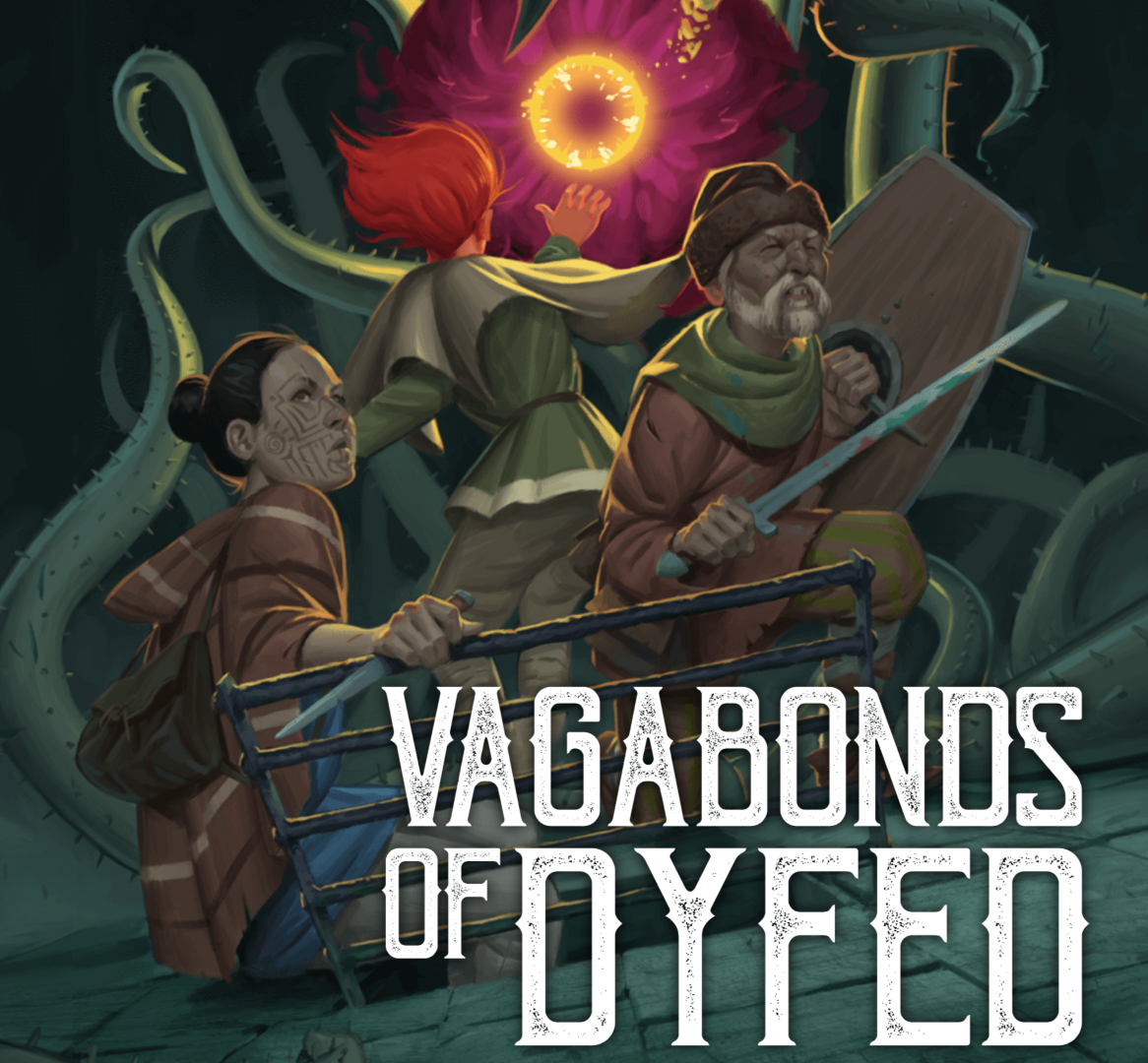
Created by Sigilstone Publishing
Vagabonds of Dyfed bridges the gap between OSR and Powered by the Apocalypse World games.
What’s interesting is the math. Most OSR games have slightly different rules and tweaks, but they all have the same math. The entire community tries to stay compatible with one another.
Ben Dutter, the creator of Vagabonds, found a clever way to blend the stats and dice math of OSR games with the loose narrative rules of Apocalypse World games.
Vow of Honor Permalink
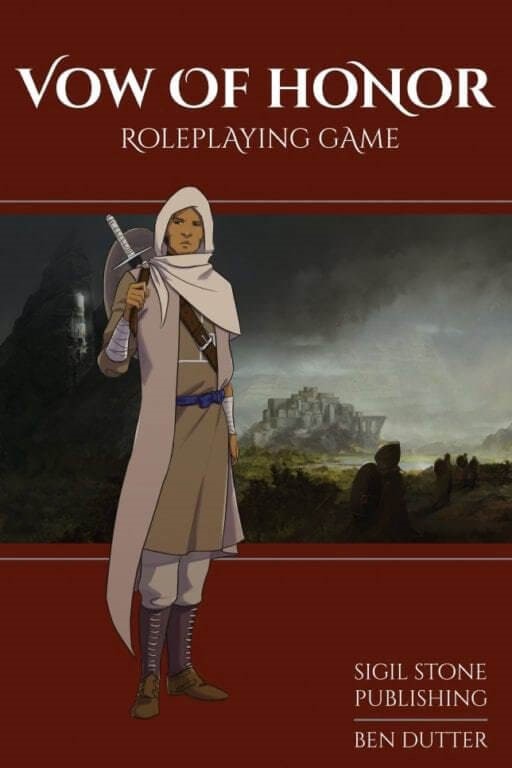
created by Ben Dutter
Vow of Honor attempts to build a game around strict codes of honor. The result is a really interesting concept where players are forced to choose between the simple, direct path and the longer, harder more honorable road. VoH uses a dice pool system where players earn dice for following their rigid codes, and lose dice for acting dishonorably.
Here’s an example: The players have been tracking the path of a known murderer for a while. They find his hideout, and watch it for a few days. Turns out the murderer goes out on his own each night to use the batthroom, unaccompanied by his flunkies. In a game of DnD, the players would simply hide outside, and jump him, killing him without any problems.
But the codes of honor dictate that you face your opponents directly, never striking a man in the back, or while he is down. So now you have a choice: Do you forgo your honor to solve the problem, or take the more dangerous route, preserving your codes.
The whole game is built around creating as many of these moments and choices as possible. If that sounds even mildly interesting to you, I highly recommend you check it out.
Warrior Poet Permalink
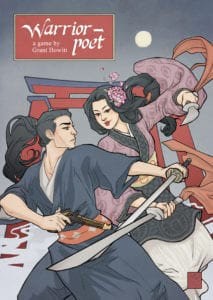
created by Grant Howitt
Do you like Haiku? Then Warrior Poet is Written just for you
Play a game where you are a Warrior-Poet; a samurai with honor, skill, and style. Duel other warriors before the watchful eye of the Emperor; vying for his approval and attention.
Your Haiku will be representative of your graceful combat, as you trade lines and stanzas back and forth with other warriors. There’s a lot of beautiful imagery in this game, and some neat ideas about competition and art. Luckily, the rules are not written in Haiku, and are explained succinctly, without too much bloat or complicated mechanics.
An extremely interesting concept. I would like to see more games embrace poetry or strict meter.
Winter’s Daughter Permalink
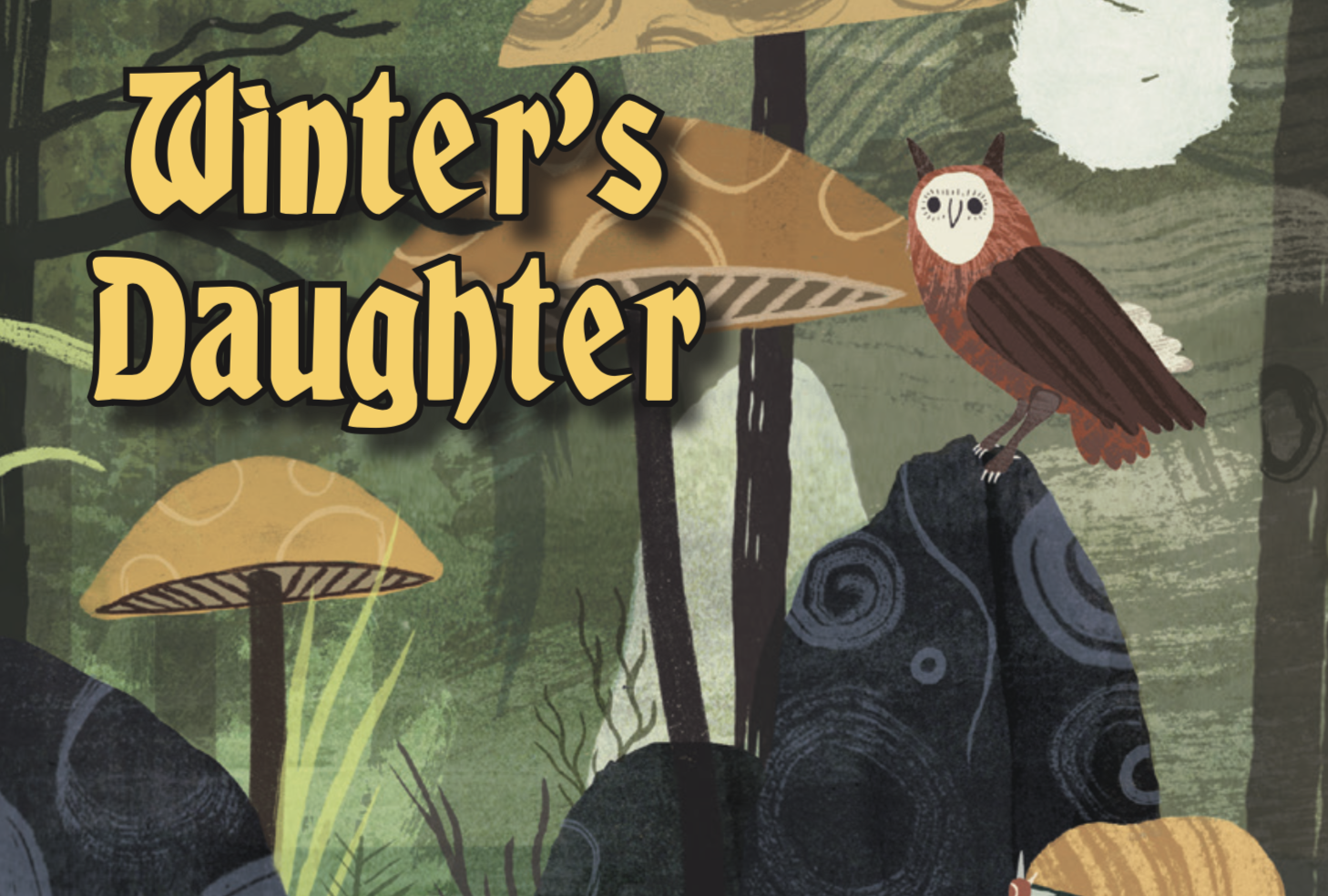
Created by Necrotic Gnome
This review is a little meandering because I had a weird experience with this adventure. One you may not have…so in short I REALLY like Winter’s Daughter, and I recommend it with one big caveat.
Wushu Permalink
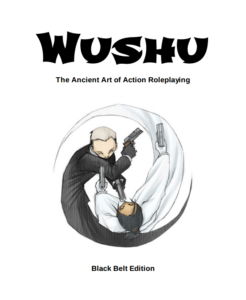
Created by Daniel Bayn
I hadn’t heard about this system before, and it was pitched to me as “the best way to choreograph a fight scene.” The number of details you include in your action descriptions increases your chances of success. I’ll let the creator describe it:
For example, someone who says “I dodge to the side” gets 1 die. Someone who says “I dodge to the side / and grab his sword blade with my chopsticks / before punching him in the face” gets 3 dice. Someone who says “I catch his sword blade with my chopsticks / when it’s chisel edge is less than an inch from my face, / then twist it around with one deft motion, / jam it into the bastard’s gut, / and whisper ‘Can’t you see I’m trying to eat, here?’” gets 5 dice. Thus, anything that contributes to the atmosphere and energy of your game becomes a smart tactic.
The game system itself uses a rather simple dice-pool mechanic. The brilliance is tying details to dice. Players naturally want more dice, and the game forces them to stretch their creativity and create a fight filled with details. Whereas other games can slow down as combat becomes more tactical, Wushu doesn’t distract from the narration and descriptions of what’s going on. After playing it once, I was hooked, and I wish more games found ways to draw out player creativity as easily as Wushu does.
Also, if you like the idea of Wushu, and are a Star Wars fan, checkout hack: Jedi Wushu.
